Makaravilakku festival
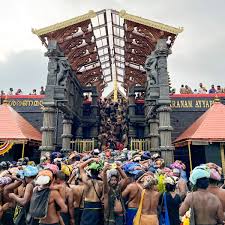
- 15 Jan 2025
In News:
Kerala police deploy 5,000 personnel at Sabarimala ahead of Makaravilakku festival.
Key Highlights:
- Makaravilakku is a prominent annual Hindu festival held at the Sabarimala Temple in Kerala, dedicated to Lord Ayyappa.
- It marks the celestial event of the Sun entering Capricorn (Makaram Rashi) on Makara Sankranti.
- The festival is a culmination of the 41-day pilgrimage to Sabarimala, celebrated with devotion, discipline, and spiritual purification.
- Sabarimala is one of the largest pilgrimage sites globally, drawing 10-15 million devotees annually.
Location:
- The Sabarimala Temple is located on the Sabarimala hill in Pathanamthitta, Kerala, within the Periyar Tiger Reserve.
- It is surrounded by 18 hills and is located along the banks of the Pamba River.
Key Rituals:
- 41-Day Pilgrimage (Vratham): Devotees observe strict practices like celibacy, fasting, and wearing black or saffron attire to purify the body and soul.
- Makaravilakku (Makara Jyothi): A celestial light appears on Makara Sankranti, believed to be a divine manifestation of Lord Ayyappa.
- Thiruvabharanam Procession: On Makaravilakku day, sacred royal ornaments (Thiruvabharanam) are carried in a procession from the Pandalam Palace to the temple.
- Aarti at Ponnambalamedu: The Makaravilakku light is believed to emanate from camphor lit during the Aarti ritual at Ponnambalamedu, viewed three times from Sabarimala.
Festival Duration:
- The Makaravilakku festival lasts for seven days, starting on Makara Sankranti and concluding with the Guruthi offering, which propitiates the gods of the wilderness.
Significance of Makaravilakku:
- The festival symbolizes the merging of celestial and spiritual energies, highlighting devotion, purity, and self-discipline.
- Devotees chant the mantra "Swamiye Saranam Ayyappa," seeking blessings and protection from Lord Ayyappa.
- The event promotes equality, as all devotees wear simple black or blue attire and carry the sacred bundle, “Irumudi Kettu.”
Cultural and Religious Aspects:
- The festival is an important cultural and religious observance for millions of Hindus.
- Though previously believed to be a supernatural event, Makaravilakku now involves a ritual performed by the Malayaraya tribe, overseen by the Travancore Devaswom Board.
Prohibition on Women:
- The temple traditionally restricts women aged 10-50 from entering. This was challenged in 2018 when the Supreme Court ruled to lift the prohibition, although it remains a contentious issue.
National Youth Day 2025
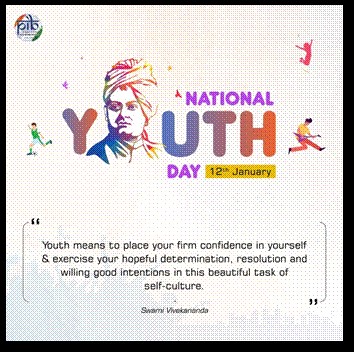
- 13 Jan 2025
In News:
On January 12, 2025, Prime Minister Shri Narendra Modi participated in the Viksit Bharat Young Leaders Dialogue 2025, an event aimed at empowering India's youth and charting a roadmap for the nation's development. This occasion also coincided with the celebration of National Youth Day, marking the 163rd birth anniversary of Swami Vivekananda, a renowned spiritual leader and social reformer who strongly believed in the transformative potential of India's youth.
Significance of National Youth Day
- Purpose:
- National Youth Day is celebrated to honor Swami Vivekananda's contributions, emphasizing the role of youth in nation-building.
- It promotes empowerment, leadership, and innovation among the youth.
- Year of First Celebration: 1985
- Key Theme (2025): "Arise, Awake, and Realize the Power You Hold"
Key Highlights from the Dialogue
- Goal of the Dialogue:
- Engaging youth in the decision-making process for a developed India by 2047.
- Empowering youth through platforms like quizzes, essay competitions, and thematic presentations.
- Ten Key Themes Discussed:
- Technology & Innovation
- Sustainability
- Women Empowerment
- Manufacturing & Agriculture
- Education and Skill Development
India’s Roadmap for 2047 (Viksit Bharat)
- Vision:
- Economic Power: India is moving toward becoming the third-largest economy.
- Strategic and Cultural Strength: India will have a robust economic, strategic, social, and cultural framework.
- Youth's Role: Innovation in technology, digital economy, space, and manufacturing will drive India’s growth.
- Key Projects and Targets:
- Target: Generating 500 GW of renewable energy by 2030.
- Net Zero Emissions for Railways: Set for 2030.
- Olympics: India aims to host the Olympics in the next decade.
- Space Power: Plans for a space station by 2035.
Viksit Bharat Young Leaders Challenge
- Objective:
- Engage youth in shaping ideas for a developed India.
- The Viksit Bharat Young Leaders Dialogue is part of the Viksit Bharat Challenge.
- Stages of the Challenge:
- Viksit Bharat Quiz: Participation by 30 lakh youth.
- Essay Writing: Over 2 lakh essays on key developmental themes.
- State Rounds: Rigorous in-person competition to identify the top young leaders.
- Participant Categories:
- 1,500 from Viksit Bharat Challenge Track.
- 1,000 from Traditional Track (cultural and science innovation).
- 500 Pathbreakers (leaders in diverse sectors).
Achievements Under Government Benefiting Youth
- Educational Reforms:
- Increase in IITs, IIITs, IIMs, and AIIMS.
- Growth in the number of higher education institutions and their global rankings.
- Economic Growth:
- India's economy has grown to nearly $4 trillion.
- Infrastructure Investments: More than ?11 lakh crore allocated for infrastructure development.
- Employment Opportunities for Youth:
- Mudra Loans: ?23 lakh crore distributed to youth entrepreneurs.
- Startup Ecosystem: India is among the top three in global startups.
- PM Gati Shakti Mission: Facilitating logistics and infrastructure development, creating employment opportunities.
Future Outlook
- Youth as the Future Leaders of India:
- India’s Youth Power: Vital to achieving a developed nation by 2047.
- The Viksit Bharat Young Leaders Dialogue is a platform for youth to voice their opinions and engage with policymakers.
- Role of Youth in India’s Transformation:
- Collective Responsibility: Every citizen's effort is essential for national goals.
- The vision of a Viksit Bharat hinges on the innovative contributions and ownership by young minds.
Flamingo Festival 2025
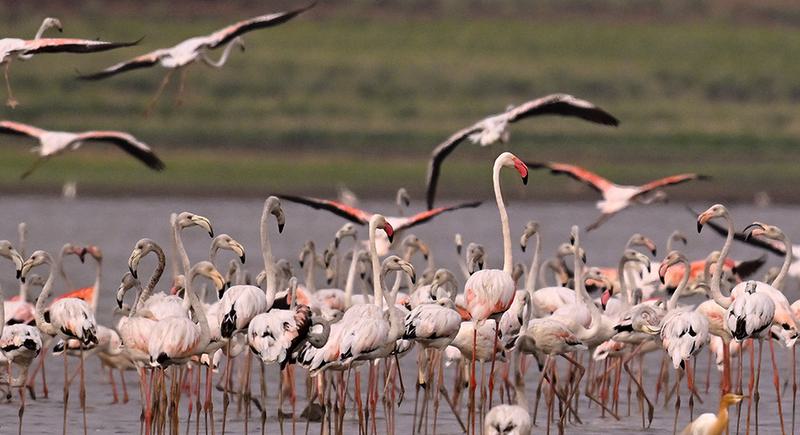
- 10 Jan 2025
In News:
The Flamingo Festival 2025 took place at Sullurpeta, in Tirupati district, Andhra Pradesh. It celebrates the arrival of migratory birds, with a focus on flamingos, to the region's key bird habitats, including Pulicat Lake and Nelapattu Bird Sanctuary.
Key Highlights:
- Birdwatching: Over 200 bird species, including flamingos, are expected to flock to the region during this festival.
- Locations: The event spans across five locations:
- Nelapattu Bird Sanctuary
- B.V. Palem (Pulicat Lake)
- Atakanithippa
- Sri City
- Sullurpeta (site for cultural programs and stalls)
- Collaborations: In association with organizations like the Bombay Natural History Society.
- Focus on Local Community: Local residents of the eco-sensitive zone will be prioritized and supported.
Key Facts on Local Wildlife and Significance:
- Pulicat Lake:
- Location: On the Andhra Pradesh-Tamil Nadu border, with 96% of the lake in Andhra Pradesh.
- Significance: The second-largest brackish water lake in India (after Chilika Lake in Odisha).
- Biodiversity: Critical habitat for migratory birds, including flamingos, and home to diverse flora and fauna.
- Economic Importance: Supports local fisheries and provides livelihood to nearby communities.
- Nelapattu Bird Sanctuary:
- Location: 20 km north of Pulicat Lake.
- Ecological Role: Largest breeding site in Southeast Asia for spot-billed pelicans.
- Biodiversity: 189 bird species, including painted storks and glossy ibises.
- Flora and Fauna: Features Barringtonia swamp forests and southern dry evergreen scrub, critical for biodiversity conservation.
- Symbiotic Relationship with Locals: Guano (bird droppings) from pelicans serves as a natural fertilizer for local agriculture, benefiting the farmers.
Flamingo Facts:
- Species: India hosts two flamingo species:
- Greater Flamingo (larger size, pale pink)
- Lesser Flamingo (smaller size, bright pink)
- Behavior: Nomadic and social birds, found in large flocks.
- Coloration: Flamingos' pink color comes from carotenoids in their diet, which are broken down and absorbed into their bodies.
Environmental & Economic Impact: The festival, apart from being a celebration of migratory birds, plays a vital role in:
- Eco-tourism development
- Biodiversity conservation
Local community engagement by highlighting sustainable tourism practices and supporting local livelihoods through eco-friendly initiatives like the Mahatma Gandhi National Rural Employment Guarantee Scheme (MGNREGS).
Toda Tribe
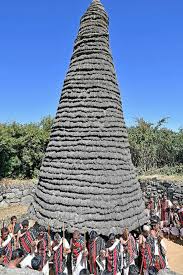
- 11 Jan 2025
In News:
- The Toda tribe, one of the oldest Dravidian ethnic groups in the Nilgiris Hills of Tamil Nadu, celebrated their traditional Modhweth festival marking the New Year.
What is the Modhweth Festival?
- About:
- Celebrated annually on the last Sunday of December or the first Sunday of January.
- Held at the Moonpo temple in Muthanadu Mund village, Nilgiri district.
- The Moonpo temple features a unique vertical spire with a thatched roof and a flat stone on top, making it one of the last Toda temples of its kind in the Nilgiris.
- Rituals and Celebrations:
- Prayers are offered to the deity, Thenkish Amman, for good health, rains, and bountiful harvest.
- Participants perform a traditional dance outside the temple.
- Unique Customs:
- Toda youth showcase their strength and masculinity by lifting a greased boulder weighing around 80 kg.
- Women are not part of the celebrations as per traditional customs.
What is the Toda Tribe?
- About:
- A pastoral tribe native to the Nilgiri Hills of Tamil Nadu.
- Classified as a Particularly Vulnerable Tribal Group (PVTG) in Tamil Nadu.
- The Toda language is Dravidian but stands out for its uniqueness among Dravidian languages.
- Significance:
- Toda lands are part of the Nilgiri Biosphere Reserve, a UNESCO International Biosphere Reserve.
- Their territory is also recognized as a UNESCO World Heritage Site.
- Religion and Beliefs:
- Their religious practices are based on a pantheon of gods, with Tökisy (goddess) and Ön (god of the underworld) as central deities.
Nilgiri Biosphere Reserve (NBR)
- About:
- Established in 1986 as India’s first Biosphere Reserve.
- Located across Tamil Nadu, Karnataka, and Kerala.
- India’s first biosphere reserve under UNESCO’s Man and the Biosphere Programme.
- Tribal Groups in NBR:
- Home to several groups such as Adiyan, Aranadan, Kader, Kurichian, Kuruman, and Kurumbas.
- Ecological Significance:
- Represents the confluence of Afro-tropical and Indo-Malayan biotic zones.
- Fauna:
- Home to species like Nilgiri tahr, Nilgiri langur, gaur, Indian elephant, Nilgiri danio (freshwater fish), and Nilgiri barbare.
- Protected Areas in NBR:
- Mudumalai Wildlife Sanctuary, Wayanad Wildlife Sanctuary, Bandipur National Park, Nagarhole National Park, Mukurthi National Park, and Silent Valley.
Bhashini Initiative
- 09 Jan 2025
In News:
e-Shram Portal, which aims to provide social security benefits to unorganised workers, has been upgraded with multilingual functionality for all 22 scheduled languages of India. This development, supported by the Bhashini Initiative, ensures that unorganised workers from diverse linguistic backgrounds can access the portal more easily and benefit from government welfare schemes.
About Bhashini Initiative:
- Launched in: July 2022
- Developed by: Ministry of Electronics and Information Technology (MeitY)
- Aim: To eliminate language barriers in accessing digital services by making AI and Natural Language Processing (NLP) tools publicly available.
Key Features:
- Local Language Translation: Bhashini offers AI-powered translation services in 22 scheduled Indian languages to ensure that digital platforms like e-Shram are accessible to everyone in their native languages.
- Open AI and NLP Resources: These tools are made available to Indian MSMEs, startups, and innovators to create a more inclusive digital ecosystem.
- Crowdsourcing Platform (Bhashadaan): A platform for people to contribute to building linguistic datasets through initiatives like Suno India, Likho India, Bolo India, and Dekho India, furthering language diversity in digital services.
- National Digital Public Platform: Aimed at providing universal access to digital content in all Indian languages, facilitating smoother communication across regions.
e-Shram Portal: A One-Stop Solution for Unorganised Workers
- Purpose: The e-Shram portal was created to provide unorganised workers with access to social security benefits and welfare schemes.
Recent Upgrade:
- Multilingual Functionality: The portal has now been upgraded to support 22 scheduled languages, making it more inclusive and user-friendly for workers who speak various regional languages.
- Previous Version: Previously, the portal was only available in English, Hindi, Kannada, and Marathi. The integration of 22 languages is a significant improvement, enabling broader participation.
Importance of the e-Shram Portal for Unorganised Workers:
- Welfare Access: The portal provides access to government schemes designed for the welfare, livelihood, and well-being of unorganised workers, including gig and platform workers and building and construction workers.
- Integration of Social Security Schemes:
- As of now, the portal facilitates access to 12 government schemes, with plans to integrate even more, including state-level programs.
- Future plans include launching a mobile app, a single application form, and the integration of payment gateways for faster disbursement of benefits.
Saint Narahari Tirtha
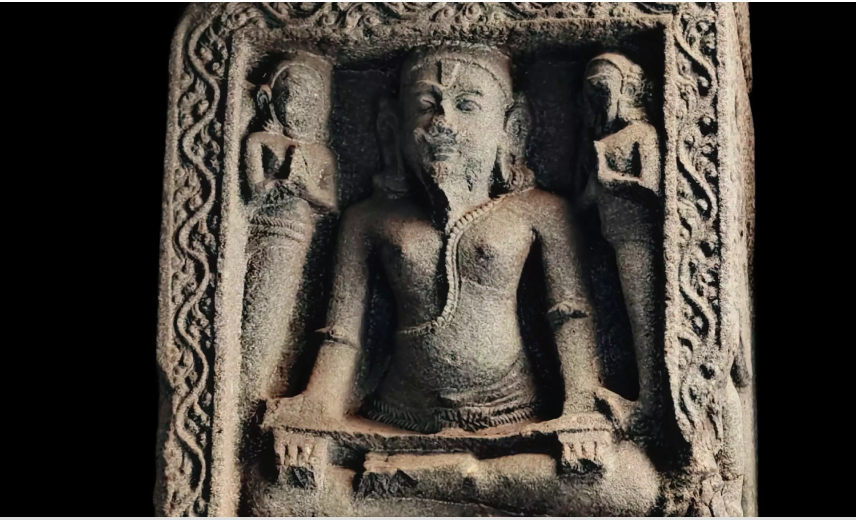
- 05 Jan 2025
In News:
In a remarkable discovery, a member of the Team of Research on Culture and Heritage (TORCH) has hit upon a three-foot idol of the 13th Century saint, Narahari T?rtha recently.
Key Highlights:
Birth and Early Life:
- Born circa 1243 CE in Chikakolu (modern-day Srikakulam, Andhra Pradesh).
- Hailing from an aristocratic family in the Gajapati Empire of Odisha.
Philosophical Influence:
- A prominent disciple of Madhvacharya, the founder of Dvaita philosophy (dualism).
- Narahari Tirtha played a key role in propagating Madhva's Vaishnavism in Eastern India, particularly in the Kalinga region (modern-day Odisha and Andhra Pradesh).
Role in Eastern Ganga Dynasty:
- Served as a minister in the Eastern Ganga Dynasty for over 30 years.
- Guided kings to align their governance with Sanatana Dharma and reformed temple administration.
- His contributions are documented in inscriptions at the Simhachalam and Srikurmam temples.
Religious and Cultural Contributions:
- Played a key role in spreading Vaishnavism and Dvaita philosophy.
- First to compose Devaranamas in Kannada, marking a significant cultural contribution.
- Contributed to the development of Yakshagana Bayalata (a dance-drama) and the classical dance form that evolved into Kuchipudi.
Writings and Intellectual Legacy:
- Authored 15 works, with two surviving texts: Gita Bhasya and Bhavaprakasika.
- His teachings and writings significantly impacted the Madhva tradition and regional literature.
Discovery of the Idol:
- A three-foot idol of Narahari Tirtha was discovered at Simhachalam Temple in Visakhapatnam, Andhra Pradesh.
- The idol depicts Narahari Tirtha holding a script on palm leaves, flanked by devotees.
Contributions to Temple and Education:
- Transformed the Simhachalam Temple into a renowned center for Vaishnavism.
- Played a crucial role in safeguarding sacred idols like Moolarama and Moola Sita for Madhvacharya.
Cultural and Artistic Legacy:
- Promoted regional art forms, helping establish Kuchipudi as a classical dance style in Andhra Pradesh.
- Advocated for Yakshagana Bayalata, a form of dance-drama popular in coastal Karnataka.
Honors and Recognition:
- Bestowed titles such as "Loka Surak?a?a Ati Nipu?a?" and "Yo Avati Kalinga Bhu Sambhav?n" for his contributions to philosophy and governance.
Final Resting Place:
- Narahari Tirtha was consecrated near Chakratirtha at Hampi on the banks of the Tungabhadra River after his death.
- His legacy continues to influence the temple traditions, especially in Puri Jagannath, strengthening the Madhva influence in Odisha.
Thanthai Periyar Memorial
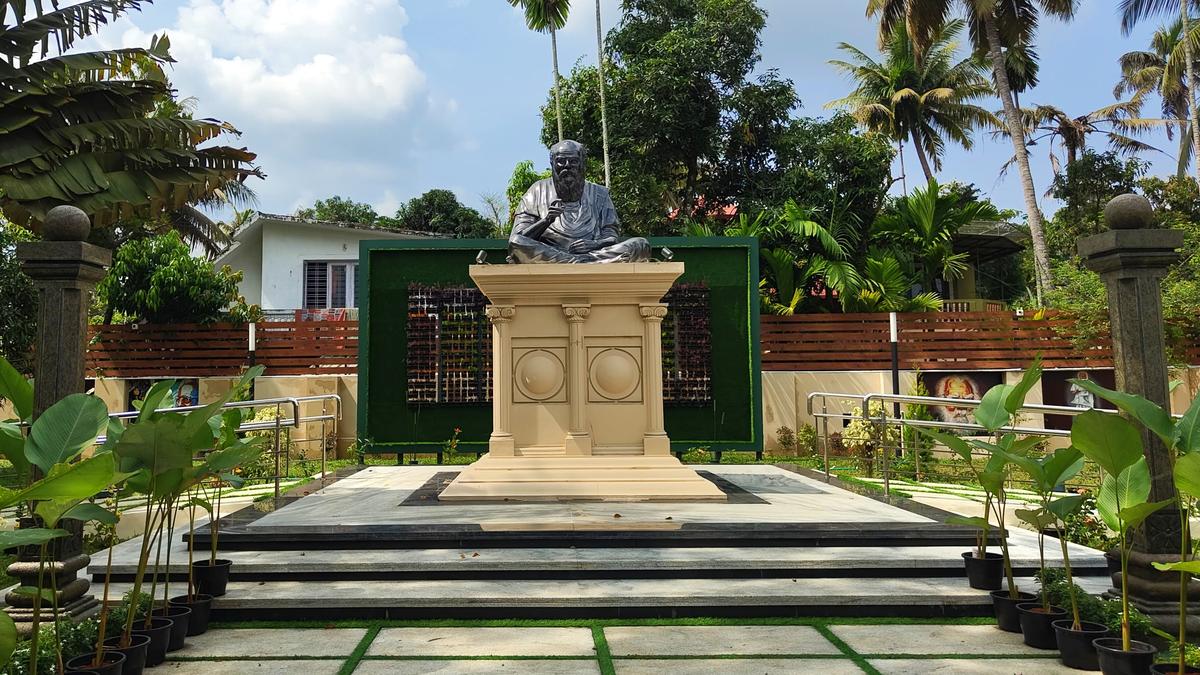
- 05 Jan 2025
In News:
In a significant event for both Kerala and Tamil Nadu, Kerala Chief Minister Pinarayi Vijayan and Tamil Nadu Chief Minister M.K. Stalin are set to reunite at Vaikom, to inaugurate the extensively renovated memorial dedicated to Tamil reformist E.V. Ramasami Naicker, popularly known as Thanthai Periyar. This marks a historic occasion over a year and a half after they jointly inaugurated the centenary celebrations of the Vaikom Satyagraha.
Key Highlights:
Memorial History and Significance:
- Established: January 1994
- Location: 70-cent property near Valiyakavala Junction, Vaikom
- Ownership: Tamil Nadu Government
- Periyar Statue: Installed in 1985 on 84 cents of land provided by Kerala government; remains the centerpiece.
- Historical Neglect: The memorial suffered from years of neglect before the renovation.
Role of Periyar in Vaikom Satyagraha:
- Vaikom Satyagraha (1924–1925):
- First organized movement for the rights of the ‘untouchable’ communities in India.
- Led by prominent leaders like T.K. Madhavan, K.P. Kesava Menon, and K. Kelappan.
- Periyar, alongside his wife Nagamma, joined the movement, seeking access to public roads leading to the Sri Mahadeva Temple in Vaikom.
- Periyar’s Contribution:
- Was imprisoned twice for his participation in the movement.
- Honored with the title Vaikom Veeran for his leadership.
- Impact: The movement played a crucial role in securing social equality for all sections of society.
Periyar’s Legacy:
- Self-Respect Movement: Founded by Periyar to promote social equality and eliminate caste-based discrimination.
- Dravidar Kazhagam: A political and social organization founded by Periyar, advocating for the rights of the Dravidian people.
- Father of the Dravidian Movement: Periyar’s philosophy and activism laid the foundation for the Dravidian political ideology and social reforms in Tamil Nadu.
Tamil Nadu's First Glass Bridge in Kanyakumari
- 02 Jan 2025
In News:
- The Chief Minister of Tamil Nadu inaugurated India’s first glass bridge over the sea in Kanyakumari, connecting the Thiruvalluvar Statue and the Vivekananda Rock Memorial.
- The bridge provides a safe and scenic walking route between these two iconic landmarks, eliminating the need for ferry trips.
Key Highlights:
- Dimensions and Design
- The bridge is 77 meters long and 10 meters wide, offering uninterrupted views of the sea from a unique vantage point.
- Designed to withstand marine conditions like corrosion and strong winds, ensuring durability and safety for visitors.
- Tourism Investment
- The bridge was built at a cost of ?37 crore, marking a significant investment in tourism infrastructure for Kanyakumari.
- This project aligns with the state’s vision to boost tourism and modernize amenities in the region.
- Significance as a Tourist Attraction
- The bridge is set to become a landmark tourist attraction, enhancing the visitor experience by providing a direct, scenic route between the two monuments.
- It is expected to play a pivotal role in boosting tourist footfall and the local economy.
About Thiruvalluvar Statue
- Location and Design
- The Thiruvalluvar Statue stands on a rock near the Vivekananda Rock Memorial in Kanyakumari.
- It is a symbol of wisdom, officially named the Statue of Wisdom by the Tamil Nadu government.
- Physical Specifications
- The statue stands at a total height of 133 feet (41 meters), with the statue itself measuring 95 feet (29 meters) and the pedestal adding 38 feet (12 meters).
- Weight: The statue weighs approximately 7000 tonnes and is designed in a hollow structure.
About Vivekananda Rock Memorial
- Location and Significance
- Situated on a rock in the Laccadive Sea, around 500 meters from the mainland in Kanyakumari.
- The memorial commemorates Swami Vivekananda, who represented India’s spiritual legacy at the 1893 Parliament of World’s Religions in Chicago.
- Historical and Religious Importance
- The rock is believed to be the site where Swami Vivekananda attained enlightenment.
- It is also associated with goddess Kanyakumari, who is said to have prayed to Lord Shiva on this rock, with an imprint of her feet preserved there.
- Architectural Features
- The memorial incorporates diverse architectural styles, including the Sripada Mandapam and the Vivekananda Mandapam.
- A life-sized bronze statue of Swami Vivekananda is located at the memorial.
- The rock is surrounded by the Bay of Bengal, Indian Ocean, and Arabian Sea, where these three water bodies converge.
ASI Discovery at Srisailam Temple
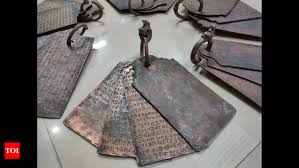
- 30 Dec 2024
In News:
- The Archaeological Survey of India (ASI) uncovered ancient copper plates and gold coins at the Srisailam Temple in Andhra Pradesh, specifically in the Ghantamandapam area.
- The discovery includes 20 sets of copper plates, totaling 72 leaves, and various gold coins.
- The ASI's Epigraphy Branch in Mysore has completed the documentation of these findings, and the materials are being studied in detail.
Collaboration with Srisailam Devasthanam:
- In collaboration with the Srisailam Devasthanam, ASI plans to publish a book that will detail the findings and their historical significance.
- The book will be printed soon by Pragati Publications in Hyderabad.
Srisailam Temple Overview:
- The Srisailam Temple, also known as the Mallikarjuna Swamy Temple, is a prominent Hindu pilgrimage site in Andhra Pradesh.
- It is located in the Nallamala Hills, overlooking the Krishna River.
- The temple is dedicated to Lord Shiva in the form of Mallikarjuna Swamy and Goddess Parvati as Bhramaramba Devi.
- It is one of the 12 Jyotirlingas of Lord Shiva and one of the Shakti Peethas, making it significant in both Shaivism and Shaktism.
Architectural Significance:
- The temple is built in the Dravidian style, featuring lofty towers and expansive courtyards, and is considered a prime example of Vijayanagara architecture.
- Historical references to the temple date back to the Satavahana period (2nd century AD), and the temple was further endowed by the Kakatiyas and Vijayanagara rulers.
Cultural and Religious Importance:
- The Srisailam Temple is unique for housing both a Jyotirlinga (Lord Shiva) and a Shakti Peetha (Goddess Bhramaramba), a rare combination not found at other temples.
- The great religious figure Adi Shankaracharya is believed to have visited the temple and composed the Sivananda Lahiri there.
Historical Context:
- The copper plates and inscriptions discovered are likely to provide valuable insights into the historical and cultural significance of the temple, as well as the region's ancient religious practices.
Re-emergence of the Dodo in Kashmir’s Papier Mâché Craft
- 30 Dec 2024
In News:
Artisans in Srinagar, Kashmir, have revived the extinct dodo bird in papier mâché forms. These figurines are exported worldwide, particularly to Mauritius and Europe, ahead of the Christmas season. Over 50,000 dodo figurines have already been sent to international markets in 2024.
Key Highlights:
The Dodo:
- Scientific Name: Raphus cucullatus.
- Extinct Since: 1681, approximately 80 years after humans began interacting with them.
- Endemic to Mauritius: A flightless bird from the Indian Ocean island of Mauritius, a national symbol of the country.
- Extinction Causes: Overhunting and the introduction of invasive species like rats, pigs, and cats that preyed on their eggs.
- Physical Traits: Grey or brown plumage, about 3 feet tall, flightless and fearless.
Papier Mâché Craft in Kashmir:
- History: Practiced for over 600 years in Kashmir, introduced during the reign of King Zain-ul-Abidin (15th century).
- Techniques: Involves creating decorative objects using paper pulp, with traditional Persian motifs.
- Recent Addition of Dodo: The dodo was introduced to the papier mâché craft around two decades ago, likely by Mauritian tourists.
International Market and Demand:
- Mauritius: A significant market for the papier mâché dodo, as the bird is a national emblem of Mauritius.
- Europe: Exported to European countries during the Christmas season, contributing to the popularity of Kashmir’s handicrafts.
- Kashmir's Karkhanas: Local craft workshops in Srinagar are producing thousands of dodo figurines each season, with over 3,000 dodos produced this year.
Cultural and Economic Impact:
- Artisans' Contribution: Local artisans are helping keep the memory of the extinct dodo alive, while boosting Kashmir’s handicraft industry.
- Global Recognition: The dodo is now a sought-after item in global markets, linked to the traditional art of Kashmir.
- Kashmir Handicrafts: Several crafts from Kashmir, including papier mâché, have received Geographical Indication (GI) tags for their distinct cultural and regional significance.
ASI Decodes Sanskrit Inscription Found in Pakistan-Occupied Kashmir (PoK)
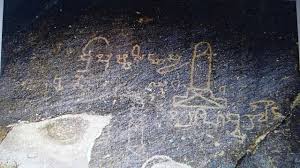
- 29 Dec 2024
In News:
An ancient Sanskrit inscription found in Gilgit (PoK) was decoded by the Archaeological Survey of India (ASI).
About the Inscription:
- Location:
- Gilgit (PoK): Written in Brahmi script, dating back to 4th century CE.
- Peshawar (Pakistan): Written in Sharada script, dating to 10th century CE.
- Details of Gilgit Inscription:
- Mentions Pushpasingha, who installed a Mahesvaralinga for the merit of his guru.
- Written in Brahmi script, which was prevalent during the 4th century CE.
- Religious Context: Indicates significant religious connection, particularly with Shaivism.
- Details of Peshawar Inscription:
- Fragmentary: Engraved on a slab.
- Written in Sharada characters (10th century CE).
- Mentions Buddhist Dharini (chants), particularly referring to Da (Dha) rini in line six.
- The inscription is partially damaged, and further details are unclear.
- Earlier Discoveries:
- This is not the first Sanskrit inscription decoded from Pakistan. In the past, Sanskrit inscriptions have been found in various parts of Pakistan.
- Swat Valley: Known for numerous Buddhist rock inscriptions in Sanskrit using Nagari script, which were part of the Gupta Empire (circa 240–550 CE).
- Religious and Cultural Implications:
- The Gilgit inscription provides evidence of Shaivism as a prominent religious practice in the region during the 4th century CE.
- The Peshawar inscription suggests Buddhist influences, particularly related to Buddhist chants and rituals.
- Swat Valley's Role: The inscriptions found here highlight its importance as a center of Buddhist learning and cultural exchange.
Neolithic Age Grooves Discovery Near Boothapandi
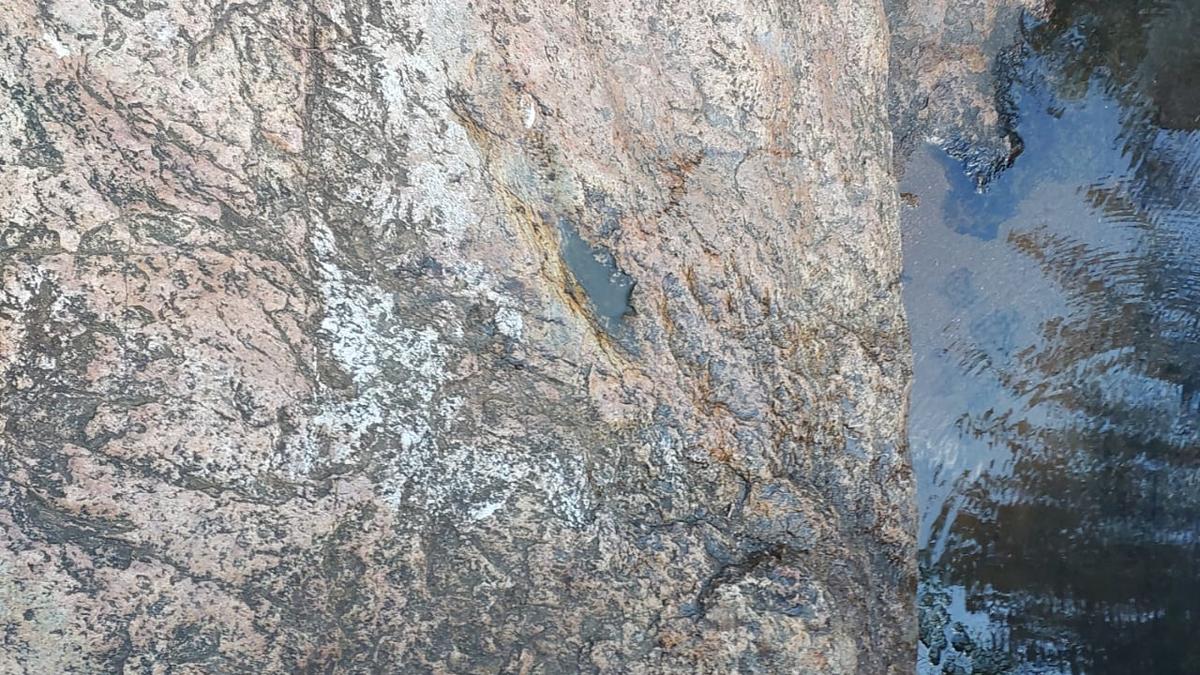
- 28 Dec 2024
In News:
- Archaeological Survey of India (ASI) discovered rock grooves created during the Neolithic age near Boothapandi village, Kanniyakumari district.
- The discovery was made by K. Hari Gopalakrishnan (Archaeological Officer, Tirunelveli and Kanniyakumari districts) and M. Faisal (Sembavalam Research Centre).
Key Highlights:
- Groove Characteristics:
- The grooves are approximately 4,000 years old, formed by Neolithic people for tool sharpening.
- Tools used for activities like hunting, ploughing, and digging were sharpened here.
- The grooves resulted from wear and tear of tools that had broken or worn out during use.
- Groove Dimensions:
- Largest groove: 15 cm in length, 4 cm in width.
- Smallest groove: 8 cm in length, 3 cm in width.
- Similar Discoveries:
- Similar grooves have been found in other parts of Tamil Nadu, including Krishnagiri, Tiruvannamalai, and Villupuram.
- Significance:
- The grooves provide evidence of Neolithic human habitation in the region.
- Ongoing excavations are expected to uncover more about Neolithic culture in the area.The Hindu
Centenary of Belgaum session
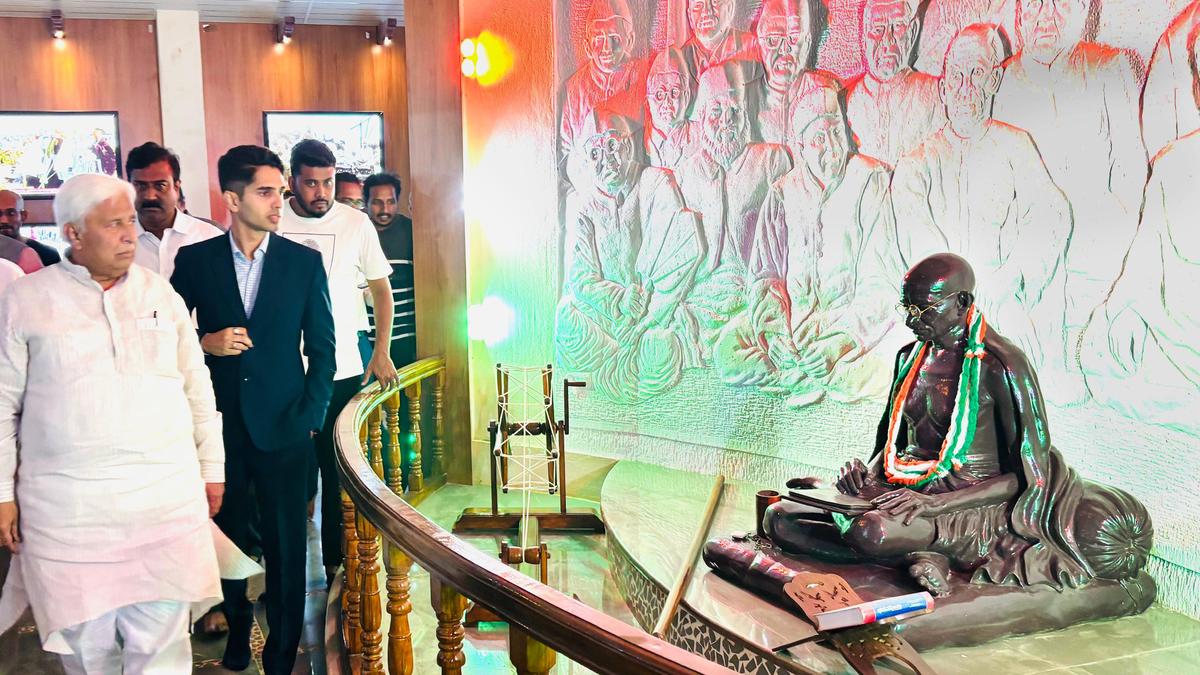
- 23 Dec 2024
In News:
The Belagavi Session of 1924, marking its centenary in December 2024, holds significant historical and cultural value in India's freedom struggle. This session, the 39th All-India Congress session, was presided over by Mahatma Gandhi, the only instance he served as the Congress president. It took place in Belagavi, Karnataka, from December 26-27, 1924, amidst a growing momentum for India’s fight against British colonial rule.
Key Aspects of the Belagavi Session:
- Gandhi's Leadership: This was the only Congress session Gandhiji chaired, marking a pivotal moment in the freedom movement. His leadership emphasized non-violence, self-reliance, and unity among diverse groups, setting the stage for future movements like the Salt March and Quit India Movement.
- Focus on Social Change: Gandhi used the session to push for social reforms, including the abolition of untouchability, promotion of khadi (hand-spun cloth), and supporting village industries. These initiatives aimed to make Congress a movement for both political freedom and social upliftment.
- Promoting Hindu-Muslim Unity: Gandhi strongly advocated for Hindu-Muslim unity, recognizing its critical importance in the larger struggle for independence. His stance emphasized communal harmony during a time of social and political divisions.
- Cultural Impact: The session also featured musical performances, including contributions from Hindustani maestros like Vishnu Digambar Paluskar and Gangubai Hangal. The Kannada song “Udayavagali Namma Chaluva Kannada Nadu” became an anthem for the region's unification movement.
- Legacy: The session had a lasting impact, with initiatives such as promoting khadi, reducing Congress membership fees, and creating new avenues for peasant participation in the freedom movement. The Pampa Sarovara well, dug during the event, continues to provide water to parts of Belagavi.
Centenary Celebrations:
The centenary of the Belagavi Session is being celebrated with a range of events, including:
- A Congress Working Committee (CWC) meeting on December 26, 2024.
- A public rally with the theme “Jai Bapu, Jai Bhim, Jai Samvidhan.”
- Cultural events and exhibitions are also planned, including competitions, tableaux, and charkha marathons.
2023 National Tansen Samman
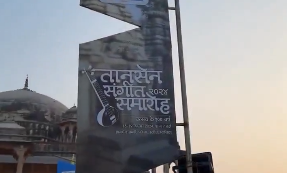
- 21 Dec 2024
In News:
- The prestigious National Tansen Samman for 2023 was conferred upon Pt. Swapan Choudhary, a renowned tabla maestro from Kolkata, at the National Tansen Festival held in Gwalior, Madhya Pradesh.
Key Highlights:
- Tansen Festival: This festival, renowned for its celebration of classical music, is organized annually in Gwalior, which is considered the music capital of Madhya Pradesh.
- Prize Details: As part of the honor, Pt. Swapan Choudhary was presented with an honorarium of five lakh rupees, a citation plaque, and a shawl-shriphal.
- About the Award:
- The National Tansen Samman was established in 1980 by the Madhya Pradesh government to recognize exceptional contributions to Indian classical music.
- It is named after Tansen, one of India's most celebrated classical musicians.
- The award is the highest national honor in the field of Indian classical music.
- Additional Award:
- Raja Mansingh Tomar Samman for 2023 was awarded to Sanand Nyas, an institution from Indore. This institution has been active for 35 years in the promotion of classical music, drama, and cultural festivals.
- Pt. Swapan Choudhary’s Remark: In response to receiving the honor, Pt. Choudhary expressed his gratitude and pride in joining the ranks of distinguished artists awarded the National Tansen Samman.
About Tansen: The Iconic Musician
- Legacy: Tansen, also known as Miyan Tansen, was a prominent Indian classical musician, composer, and vocalist. He is credited with popularizing several ragas and revolutionizing the Indian classical music tradition.
- Role at Akbar’s Court: Tansen was one of the Navaratnas (nine jewels) in the court of Mughal Emperor Akbar. He held the title of Mian, meaning "learned man," bestowed upon him by Akbar.
- Contributions:
- Tansen is famous for his compositions, including the introduction of notable ragas such as Miyan ki Malhar, Miyan ki Todi, and Darbari.
- He also improved the plucked rabab, which is of Central Asian origin, enhancing its role in Indian classical music.
- Historical Influence: Tansen's life and work are surrounded by extensive legend, and his contributions remain deeply influential in the development of Indian classical music today.
Vijay Diwas 2024
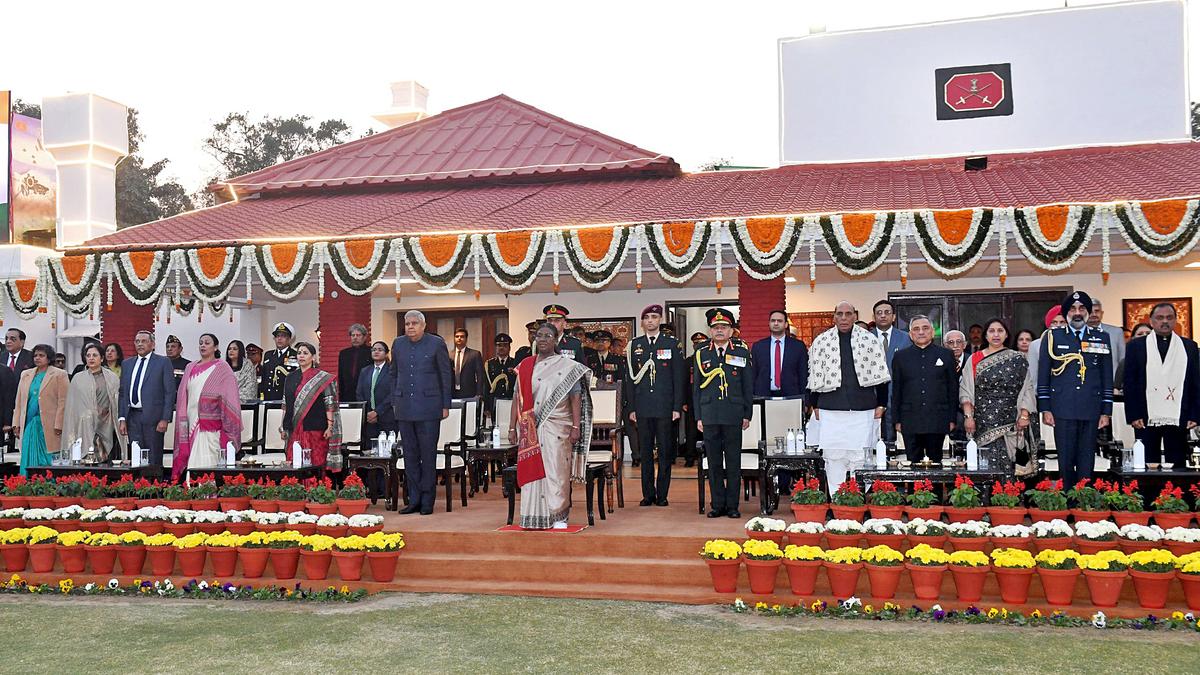
- 17 Dec 2024
In News:
On December 16, 2024, India commemorated Vijay Diwas, marking the 53rd anniversary of its victory in the 1971 Bangladesh Liberation War. This day honors the bravery and sacrifices of Indian soldiers and the Mukti Bahini, whose collective efforts led to the creation of Bangladesh as an independent nation. On this occasion, leaders across India, paid heartfelt tributes to the fallen heroes who contributed to the victory, and to the enduring India-Bangladesh friendship.
The 1971 Bangladesh Liberation War culminated in the surrender of over 90,000 Pakistani soldiers, and India’s victory is celebrated as a defining moment in South Asian history.
The War’s Historical Context:
The 1971 Bangladesh Liberation War was a pivotal conflict between East Pakistan (now Bangladesh) and West Pakistan (now Pakistan), leading to Bangladesh’s independence. It was a direct result of decades of social, political, and economic discrimination faced by East Pakistan, despite its larger population and contribution to Pakistan’s economy. Major events leading to the war included:
- Cultural and linguistic marginalization, with East Pakistan's Bengali language and identity being suppressed by the West.
- The 1970 elections that saw the Awami League, led by Sheikh Mujibur Rahman, win a decisive victory in East Pakistan, but their demand for greater autonomy was rejected by West Pakistan.
- The violent crackdown by the Pakistani military in Operation Searchlight in March 1971, leading to widespread atrocities and a mass exodus of refugees into India.
India’s Role in the War:
India’s involvement in the conflict was initially cautious, but the refugee crisis—with over 10 million people fleeing to India—forced India to take action. India provided humanitarian aid and supported the Mukti Bahini, a guerrilla force of Bangladeshi fighters. On December 3, 1971, Pakistan’s preemptive airstrike on Indian military bases led to India's retaliation and full-scale military involvement, including air and naval operations.
India’s military, with assistance from the Mukti Bahini, launched a decisive campaign, ultimately leading to Pakistan’s surrender on December 16, 1971, and the creation of Bangladesh.
Vijay Diwas Observances:
- The 53rd Vijay Diwas celebrations at Fort William, Kolkata, saw a Bangladeshi delegation—including Mukti Joddhas (freedom fighters)—reflect on their memories of the war, highlighting India's crucial role in the liberation of Bangladesh.
- The event also featured a wreath-laying ceremony, military tattoo, and a salute to the shared sacrifice and friendship between India and Bangladesh.
The 1971 Surrender Painting and New Symbolism:
In an interesting development, the iconic 1971 surrender painting, depicting the surrender of Pakistani forces in Dhaka, was moved from the Army Chief’s lounge to the Manekshaw Centre. The painting was replaced by Karam Kshetra–Field of Deeds, a new artwork symbolizing India’s strategic and cultural heritage. This new piece incorporates elements like Lord Krishna’s chariot, Chanakya, and modern military assets, reflecting India’s military prowess and heritage.
Zakir Hussain
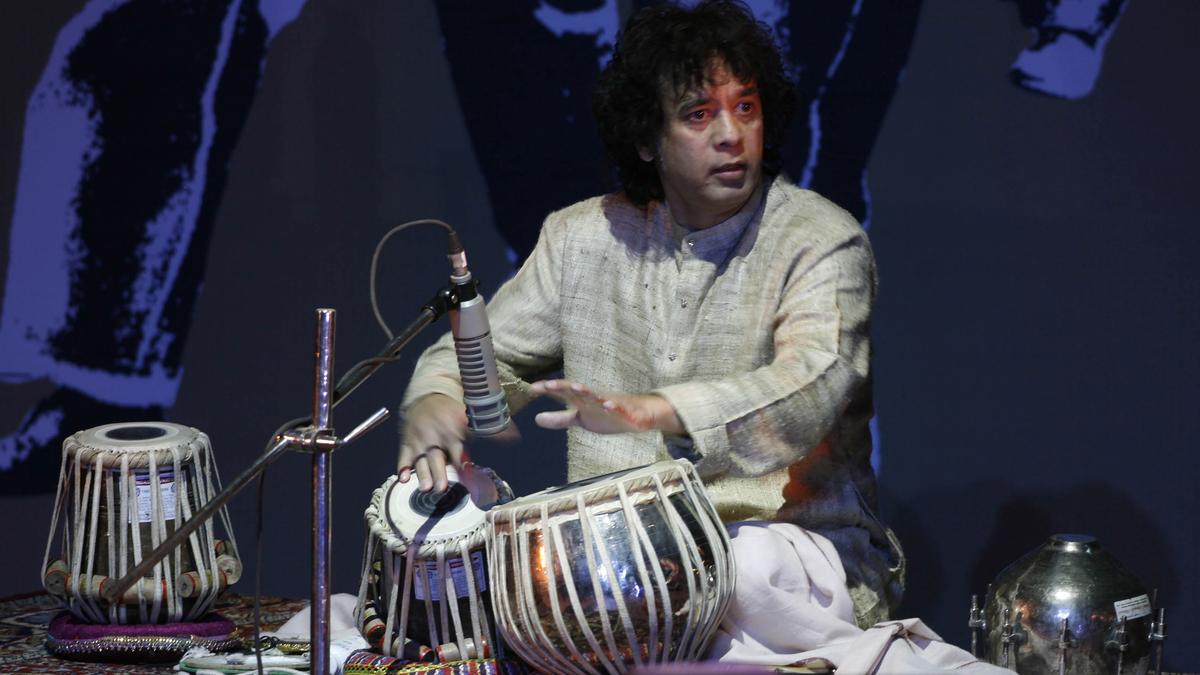
- 16 Dec 2024
In News:
Ustad Zakir Hussain, the legendary tabla virtuoso, passed away at the age of 73 due to Idiopathic Pulmonary Fibrosis (IPF).
Key Highlights:
- Career Highlights:
- Born on March 9, 1951, to Ustad Alla Rakha, a renowned tabla maestro.
- Began tabla training at age 7, with early guidance from his father.
- Co-founded Shakti in 1973 with John McLaughlin, blending Indian classical music with Western influences, pioneering world music.
- Worked with global artists, including George Harrison, John McLaughlin, and Mickey Hart.
- Awarded four Grammy Awards, including three at the 66th Grammy Awards (2024), and honored with the Padma Vibhushan in 2023.
- A visiting professor at Stanford and Princeton universities.
- Musical Style:
- Transformed the tabla from a background instrument into a dynamic, expressive solo performance.
- Known for his complex rhythms and spontaneous performances, making tabla accessible and glamorous.
- Emphasized the concept of "hazri" (attendance) in the court of music, seeing his music as an offering to a higher power.
- Cultural Influence:
- His music was a bridge between traditional Indian classical and contemporary global sounds, impacting audiences worldwide.
- Played a pivotal role in the cultural exchange of Indian classical music, gaining fans and respect across the globe.
- Participated in projects such as the Taj Mahal tea commercials and "Desh Raag", symbolizing unity and diversity in India.
What is Idiopathic Pulmonary Fibrosis (IPF)?
- IPF is a chronic lung disease causing scarring of the lung tissue, leading to difficulty in breathing.
- Cause: The exact cause is unknown, hence termed "idiopathic" (unexplained).
- Risk Factors: Most common in older adults (over 50), men, and those with a history of smoking or viral infections.
About the Tabla:
- Structure: Composed of two drums—Tabla (right) and Bayan (left)—used primarily in Hindustani classical music.
- Material: Tabla has a wooden body, while Bayan can be made of clay or metal, both covered with animal skin and syahi paste.
- Role: Primarily accompanies vocal and instrumental performances, and is essential in various classical dance forms in northern India.
- Historical Note: Believed to have been invented by Amir Khusrau.
Prominent Tabla Players:
- Ustad Alla Rakha (father of Zakir Hussain).
- Zakir Hussain (himself).
- Shafat Ahmed and Samta Prasad.
Under the Sal Tree Theatre Festival
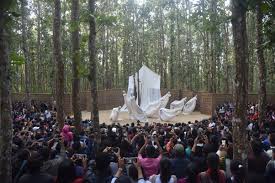
- 14 Dec 2024
In News:
“Under the Sal Tree” Theatre Festival, held annually in Rampur, Assam, promotes eco-friendly and sustainable practices in theatre while showcasing rich cultural diversity.
Overview:
- Location: Rampur village, Goalpara district, Assam
- Organizer: Badungduppa Kalakendra, a social and cultural organization
- Founded: 1998 by Sukracharjya Rabha
- Festival Focus: Eco-friendly theatre practices, cultural diversity, and sustainability
Key Features
- Unique Setting: Open-air festival under Sal trees, with no artificial lighting or electric sound systems.
- Sustainability:
- No use of plastic.
- Carbon-neutral, with eco-friendly materials such as bamboo, straw, and cane.
- Performances in natural daylight, avoiding electric lights.
- International Participation: Theatre groups from countries like Poland, South Korea, Brazil, Sri Lanka, Bangladesh, North Korea, Bolivia, and Holland have performed.
- Cultural Celebration: Highlights indigenous art forms, languages, and traditions, e.g., Rabha and Bodo plays.
Festival Activities
- Performances:
- Includes plays like “Dadan Raja” (Rabha language play), “Kindhan Charithiram” (Tamil), and “Kisan Raj” (Hindi).
- Focus on themes such as societal change and resilience of farmers.
- Workshops & Community Projects: For performing artists, promoting artistic innovation and social impact.
- Anniversary Celebrations:
- 25th anniversary celebrated with special events and book releases, e.g., “Resonance: Echoing the Spirit of Badungduppa” and “Sukracharjya Rabha on the Back Stage”.
Impact & Legacy
- Theatre Movement: Celebrates art amidst nature, breaking geographical barriers despite the remote location.
- Founder’s Vision: Sukracharjya Rabha believed in the synergy between art and nature, aiming to bring social change through theatre.
- Local Involvement:
- 20 resident artists contribute to the festival’s success.
- Festival has become a major cultural attraction in Assam, drawing thousands of theatre enthusiasts.
Turner Prize
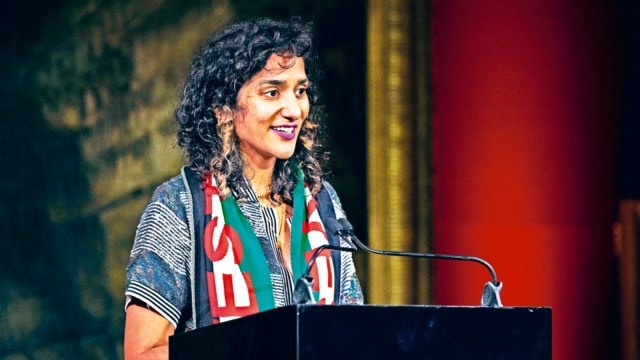
- 09 Dec 2024
In News:
Jasleen Kaur, a 38-year-old Indian-origin Scottish artist, has won the prestigious Turner Prize 2024 for her exhibition "Alter Altar". This win highlights Kaur’s unique ability to weave together personal, political, and spiritual elements into a cohesive artistic expression. The exhibition explores themes such as plurality, migration, and cultural identity, drawing from Kaur’s own family history and experiences.
Exhibition Overview:
"Alter Altar," which was first showcased in Glasgow, features an array of everyday objects and cultural symbols, including:
- A vintage red Ford Escort covered in a large crocheted doily, symbolizing her father’s migrant aspirations.
- Worship bells, Irn-Bru orange resin, an Axminster carpet, and family photographs.
- Soundtracks, including music from Nusrat Fateh Ali Khan and Bob Marley, which reflect Kaur’s multicultural upbringing.
The exhibition blends these elements to examine migration, identity, and belonging. The jury, chaired by Alex Farquharson, Director of Tate Britain, praised Kaur’s ability to combine different voices through unexpected and playful material combinations, creating a visual and aural experience that evokes both solidarity and joy.
Personal and Political Reflection:
Kaur’s work reflects on the Sikh concept of Miri Piri, which represents the balance between the political and the spiritual. This duality is central to her exploration of cultural practices and the effects of violence, colonialism, and empire on these traditions. In her acceptance speech, Kaur also addressed political issues, calling for a ceasefire in Gaza and an end to institutional complicity in Israel's actions.
About the Turner Prize:
The Turner Prize, established in 1984, is one of the most prestigious awards in contemporary British art. It aims to recognize recent developments in British art. Kaur’s win is particularly significant as it marks the 40th anniversary of the award. Previous winners include renowned Indian-origin artists such as Anish Kapoor (1991).
Hornbill Festival

- 06 Dec 2024
In News:
The Hornbill Festival, a vibrant celebration of Nagaland's culture and tourism, is an annual event that takes place from December 1 to 10.
About the Hornbill Festival:
- Origin: First held in the year 2000.
- Purpose: The festival aims to foster inter-tribal communication, preserve the cultural heritage of Nagaland, and showcase the harmonious blending of traditional and modern elements.
- Significance: Referred to as the “festival of festivals,” it has become an essential part of the state’s cultural calendar.
- Organizers: It is organized by the Tourism and Art & Culture Departments of the Government of Nagaland.
- Location: The festival takes place annually at the Naga Heritage Village in Kisama, located about 12 kilometers from Kohima.
- Cultural Showcase: Over the years, it has evolved into a significant celebration that highlights the vibrant and diverse cultural traditions of the various tribes in Nagaland.
- Name Origin: The festival is named after the Hornbill bird, which holds cultural importance among the Naga tribes.
- Theme of the 2024 Hornbill Festival:The 2024 edition is themed “Cultural Connect,” celebrating the rich heritage and cultural diversity of Nagaland. The festival continues to merge modernity and tradition through a variety of activities, including Naga wrestling, traditional archery, food stalls, fashion shows, beauty contests, and musical performances. Additionally, the Archives Branch is presenting a special exhibition titled “Naga-Land & People in Archival Mirror” in partnership with the National Archives of India, offering a deeper look at the region's history and cultural practices.
- Recent Milestone:This year marks the 25th anniversary of the Hornbill Festival.
Festival Highlights:
- Annual Event: Held each year since its inception in 2000, it serves as a major cultural event for Nagaland.
- Symbolism: Named after the Hornbill bird, which represents boldness and grandeur in Naga folklore.
- Location: The festival is hosted at Kisama Heritage Village, a cultural center that preserves Naga traditions with 17 indigenous houses (Morungs) that represent each of the tribes.
- Cultural Diversity: Nagaland, known as the “Land of Festivals,” is home to 17 major tribes, each with its distinct festivals and cultural practices. The Hornbill Festival promotes inter-tribal interaction and celebrates the state’s rich heritage.
- National Significance: Reflecting India’s unity in diversity, the festival serves as a platform for different cultural practices to coexist, strengthening the nation’s collective identity.
Notre-Dame Cathedral

- 03 Dec 2024
In News:
The Notre-Dame Cathedral in Paris, a landmark symbol of French Gothic architecture, is set to reopen on after undergoing extensive renovations following a devastating fire in April 2019.
Historical and Architectural Significance:
- Location: Situated on Île de la Cité in the Seine River, Paris.
- Construction: Began in 1163 under Bishop Maurice de Sully and completed in 1260, showcasing a blend of early Gothic to Rayonnant Gothic styles.
- Key Features: The cathedral is renowned for its rib vaults, flying buttresses, stained-glass windows, and sculpted gargoyles.
- Cultural Importance: It has been a stage for significant historical events, including Napoleon Bonaparte's coronation in 1804. It also houses the Holy Crown of Thorns and relics from the crucifixion of Jesus.
- Literary Legacy: Featured in Victor Hugo's "The Hunchback of Notre-Dame" (1831), which drew attention to its architectural and historical significance.
Modern History and Renovation:
- The cathedral endured historical events such as the French Revolution, World War II, and attacks during the Protestant Reformation.
- In April 2019, a fire severely damaged the roof and spire, sparking an international outpouring of support for its restoration.
- Renovation efforts began soon after, involving more than 1,000 craftspeople, with President Emmanuel Macron calling it “the project of the century.”
Construction and Modifications Over Centuries:
- The Notre-Dame was a model for early Gothic architecture and has undergone multiple renovations, including the addition of flying buttresses and other structural changes during the 13th and 14th centuries.
- Modifications continued through the Renaissance and Classical periods, reflecting changing artistic styles and the political moods of the time.
Significance in French History:
- Witness to History: The cathedral has been central to 800 years of French history, serving as a backdrop for both brilliant and tumultuous events.
- Religious and Political Symbolism: It was the heart of Paris' religious and political life, acting as a symbol of the intertwined relationship between the church and the monarchy.
MahaKumbh Mela 2025
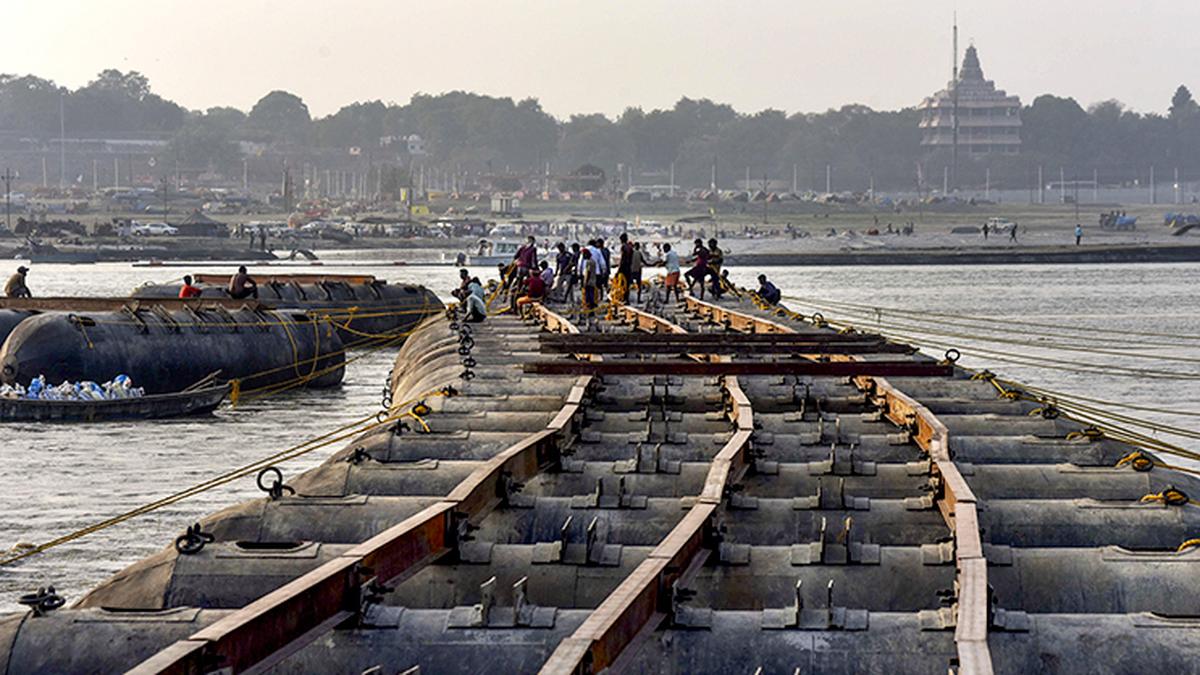
- 03 Dec 2024
In News:
- On December 1, 2024, the Uttar Pradesh government declared the MahaKumbh Mela area as a temporary district for four months.
- The new district will be known as the MahaKumbh Mela District, to streamline management for the 2025 MahaKumbh.
- Over 5,000 hectares of land will be part of this district, including 66 revenue villages from four tehsils: Sadar, Sorav, Phulpur, and Karchana.
Key Administrative Changes:
- Mela Adhikari (Kumbh Mela Officer) will act as the District Magistrate (DM) and will hold powers of Executive Magistrate, District Magistrate, and Additional District Magistrate.
- The Mela Adhikari will have authority under the Indian Civil Defense Code, 2023, and the Uttar Pradesh Revenue Code, 2006.
- The Mela Adhikari can appoint an Additional Collector for the district.
MahaKumbh Mela Overview:
- The Kumbh Mela is recognized by UNESCO as an Intangible Cultural Heritage of Humanity.
- It is the largest peaceful congregation of pilgrims, with participants bathing in sacred rivers at locations including Prayagraj, Haridwar, Ujjain, and Nashik.
- The PrayagrajKumbh takes place at the Sangam, the confluence of the Ganges, Yamuna, and the mythical Saraswati rivers.
- The event spans over a month and includes religious, cultural, and social activities, along with massive infrastructural setup including tented townships, civic facilities, and security measures.
Global Engagement Scheme
- 30 Nov 2024
In News:
- The Ministry of Culture plays a pivotal role in promoting India’s rich cultural heritage across the globe through its Global Engagement Scheme.
- The scheme is designed to enhance India's cultural image internationally while fostering people-to-people connections and strengthening bilateral cultural ties with other nations.
- The scheme has three key components: Festival of India, Grant-in-aid to Indo-Foreign Friendship Cultural Societies, and Contribution Grants.
Key Components of the Global Engagement Scheme:
- Festival of India (FoI):
- Purpose: The Festival of India is organized abroad to celebrate and promote India's diverse culture. It provides a platform for artists from various cultural fields, including Folk Art (folk music, dance, theatre, puppetry), Classical and Traditional Dance, Classical and Semi-Classical Music, Experimental/Contemporary Dance, and Theatre.
- Impact: Since 2013-14, 62 Festivals of India have been held in different countries, with over 2,348 artists, including folk artists, participating. These festivals serve as a means to promote Indian folk art, culture, and music internationally.
- Artist Participation: Folk artists are remunerated with a performance fee of ?35,000 for the leader/main artist and ?7,000 for accompanying artists per performance.
- Grant-in-aid to Indo-Foreign Friendship Cultural Societies:
- Objective: This scheme supports cultural societies abroad that aim to strengthen cultural exchanges and promote Indian art forms. Grants are provided to these societies to organize various cultural programs and activities, fostering closer cultural ties between India and the host countries.
- Support to Folk Artists: This scheme also aids in bringing folk art to the global stage, showcasing India's traditional performances.
- Contribution Grant:
- Objective: The contribution grant is used for India’s membership in international organizations like UNESCO, ICOM, and the World Heritage Fund. This component also facilitates Indian participation in international meetings and helps host global events, further showcasing India’s cultural wealth.
Support for Veteran Artists:
In addition to promoting folk culture globally, the Ministry of Culture supports veteran artists through the Financial Assistance for Veteran Artists scheme. This initiative is aimed at supporting elderly and economically disadvantaged artists (aged 60 and above) who have made significant contributions to their respective art forms, including folk art.
- Financial Support: Artists selected under this scheme receive up to ?6,000 per month, adjusted for any state pension they may already receive.
Regional Contributions:
- The Ministry has empaneled folk artists and groups across India for participation in these international cultural exchanges. For instance, two folk artists/groups and one Kathak artist from Uttarakhand are currently empaneled.
- Notably, a troupe from Uttarakhand participated in the Freedom 70 Cultural Event in Cuba and the Dominican Republic in August 2017, showcasing the diversity of Indian folk art.
- The Financial Assistance for Veteran Artists has also benefitted several artists from Uttarakhand, with four artists from the state receiving support over the past two years.
Mahabodhi Mahotsav at Sanchi
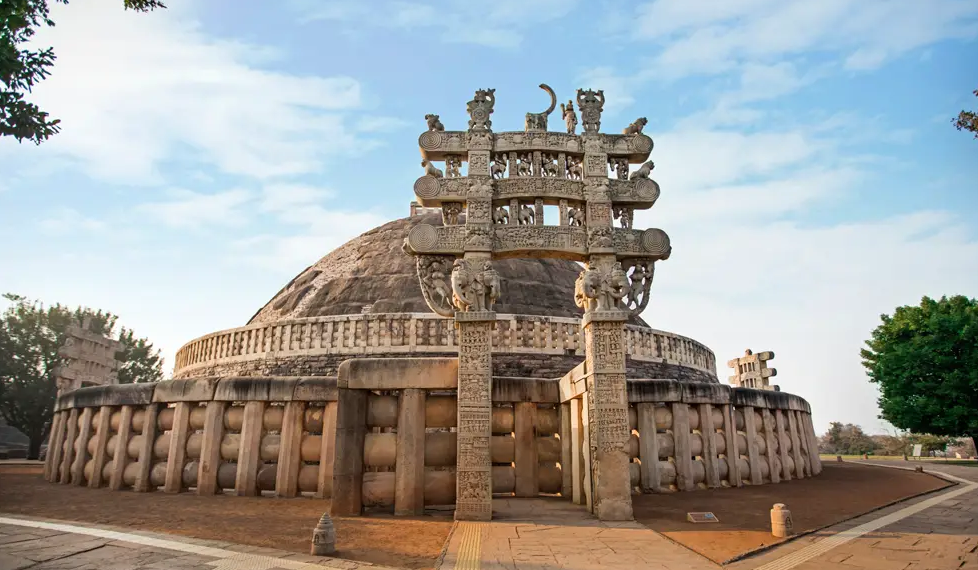
- 30 Nov 2024
In News:
A two-day Mahabodhi Mahotsav is currently being held at the Great Stupa in Sanchi, Madhya Pradesh, a UNESCO World Heritage Site.
Key Highlights:
- The festival will include religious ceremonies and cultural activities centered around the relics of Lord Buddha’s chief disciples, Sariputra and Maudgalyayana.
- Cultural Significance: The Mahotsav serves as a platform for celebrating and reaffirming the cultural and spiritual heritage of the region, with a focus on the teachings of Lord Buddha.
About Sanchi Stupa:
Sanchi Stupa is one of the oldest and most significant monuments of Buddhist architecture in India. It has stood as a symbol of Buddhist history, spirituality, and culture for over two millennia.
- Historical Importance:Commissioned by Emperor Ashoka in the 3rd century BCE, the stupa was later expanded by the Shunga and Satavahana rulers. It stands as a testament to the spread of Buddhism across India and beyond.
- Architectural Features:
- Hemispherical Dome (Anda): The large dome represents the universe, encapsulating the essence of Buddhist cosmology.
- Chatras: The umbrella-like structures on top of the dome symbolize divine protection and royalty.
- Harmika: A small balcony on the dome, which is considered the abode of the gods.
- Medhi: The base of the stupa, which stores sacred relics.
- Toranas: Four intricately carved gateways that depict scenes from the life of Buddha and various Jataka tales. These gateways point to the four cardinal directions, symbolizing the universality of Buddha’s teachings.
- Vedica: The railings surrounding the stupa serve as sacred enclosures.
- Paradakshinapatha: Pathways for circumambulation, allowing devotees to walk around the stupa as a sign of respect.
- Symbolism:The stupa’s architecture is an example of early Buddhist aniconism, where the Buddha is not directly depicted but is represented symbolically through footprints, wheels, or empty thrones.
- Inscriptions:The stupa contains important inscriptions, including the Ashokan Lion Capital and inscriptions in Brahmi and Kharosthi scripts, reflecting the historical significance of the site.
- UNESCO World Heritage Status:In 1989, Sanchi Stupa was declared a UNESCO World Heritage Site, recognizing its exceptional historical and cultural importance as a center for Buddhist art, architecture, and philosophy.
Significance of the Mahabodhi Mahotsav:
The Mahabodhi Mahotsav at Sanchi not only provides a spiritual experience but also highlights the historical and cultural legacy of Buddhism in India. The event brings attention to the preservation and promotion of Buddhist heritage, reflecting India’s rich diversity and commitment to maintaining its ancient traditions. Through this festival, Sanchi continues to be a center of pilgrimage and learning, attracting visitors from around the world who seek to understand and experience the teachings of Lord Buddha.
Ngada Festival
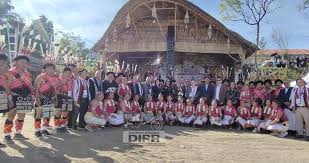
- 29 Nov 2024
In News:
The Rengma Naga tribe concluded a two-day celebration of the Ngada festival-cum-Mini Hornbill Festival at the Tseminyu RSA ground in Nagaland.
Ngada Festival Overview:
- Celebration: It is an annual celebration observed by the Rengma Naga tribe, marking the end of the agricultural cycle.
- Duration: Typically, an eight-day festival, it is celebrated towards the end of November.
- Significance: It is a festival of thanksgiving, joy, and cultural unity, with a focus on gratitude for the harvest and remembrance of departed souls.
Cultural and Ritual Aspects:
- Rituals: The festival involves rituals for protection from misfortunes, such as fire and evil spirits, as well as prayers for peace and prosperity in the community.
- Agricultural Link: The festival is celebrated after the harvest season, symbolizing the end of the agricultural cycle and the beginning of the storage of crops.
- Official Announcement: The village priest announces the start of the festival, and preparations begin shortly after.
Importance of Ngada:
- Gratitude for the Harvest: The festival is a celebration of the hard work of the agricultural year and the bountiful harvest.
- Cultural Identity: The festival serves as a vital reminder of the Rengma Naga’s cultural heritage and traditions, helping to preserve them for future generations.
- Symbol of Unity: It fosters cultural unity and strengthens community bonds within the tribe.
Tribal Demographics:
- Population: The Rengma Naga tribe has a population of around 62,951 in Nagaland and 22,000 in Assam (according to the 2011 Census of India).
- Ethnic Identity: The Rengmas belong to the Tibeto-Burman ethnic group and identify themselves as Njong or Injang.
Historical and Cultural Background:
- Migration: It is believed that the Rengmas, along with other Naga tribes, migrated from Southeast Asia, crossing the Yunnan Mountain ranges, and eventually settled in the upper Burma region.
- Slavery: Historically, slavery was practiced among the Rengmas, with slaves known as menugetenyu and it sakesa. However, by the time the British arrived, slavery was in decline, and no Rengma tribespeople were known to be slaves.
Economy:
- Agricultural Lifestyle: The Rengma Naga are primarily agriculturalists, relying on Jhum cultivation (shifting cultivation) and wet rice cultivation.
- Crops Grown: They grow staple crops like paddy, along with seasonal crops and fruits.
Religion:
- Traditional Beliefs: Traditionally, the Rengma Naga worship supernatural beings.
- Christianity: Today, most of the Rengma tribe has converted to Christianity.
Bali Jatra Cuttack Utsav 2024
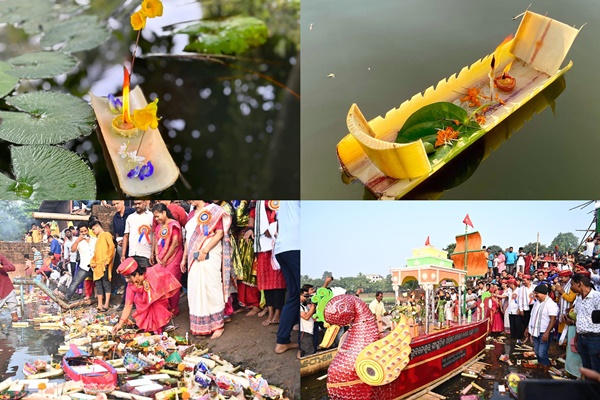
- 17 Nov 2024
In News:
- Bali Jatra 2024 is being held from November 15 to November 22 in Cuttack, Odisha.
- The festival celebrates Odisha’s ancient maritime history and its cultural and trade links with Southeast Asia.
- The event has gained international attention due to the participation of diplomats and cultural troupes from ASEAN, BIMSTEC, and Pacific Island countries.
Historical and Cultural Significance:
- Bali Jatra ("Voyage to Bali") commemorates the 2,000-year-old maritime trade routes between ancient Kalinga (modern-day Odisha) and Southeast Asia, including regions like Bali, Java, Sumatra, Borneo, Burma (Myanmar), and Sri Lanka.
- The festival honors the skills of Kalinga sailors who contributed to the prosperity of the region through trade, including commodities like pepper, cinnamon, cardamom, silk, camphor, gold, and jewelry.
- It highlights Odisha’s maritime legacy and the cultural exchanges between India and Southeast Asia, particularly the cultural influence of Odia merchants on Bali.
Commercial and Economic Aspects:
- Bali Jatra is Asia’s largest open-air trade fair, featuring over 2,500 stalls selling a variety of products including artisanal crafts, household items, and food.
- The event is a major commercial activity with business transactions estimated to exceed ?100 crore over the course of the festival.
- The festival provides an opportunity for both local and national traders to exhibit products at competitive prices.
Cultural Performances and International Participation:
- The festival includes daily cultural performances showcasing Odissi dance, Chhau dance, Bihu, Mahari, Gotipua, Sambalpuri, and Santali folk dances.
- This year, cultural troupes from countries like Indonesia, Thailand, and Sri Lanka have participated, enhancing the international profile of the festival.
- Diplomats, including Ambassadors, High Commissioners, and Heads of Mission from 14 countries attended the inaugural ceremony.
Historical Background of Bali Jatra:
- The festival is linked to Kartika Purnima, the full moon night of the month of Kartika, marking the annual migration of traders from Odisha to Southeast Asia.
- Traders used boats called Boitas to travel to distant lands, which is now symbolically represented in the festival.
- The event’s cultural significance extends to the recognition of Odisha’s historic maritime routes, with ports like Tamralipti, Manikpatna, Chelitalo, Palur, and Pithunda playing key roles in global trade from as early as the 4th century BC.
Kalinga's Maritime Influence:
- The Kalinga Empire (present-day Odisha) had significant influence over the Bay of Bengal, referred to as the Kalinga Sea.
- Kalinga’s dominance in maritime trade is reflected in Kalidasa's Raghuvamsa, where the King of Kalinga is called "Lord of the Sea."
- Kalinga's Boitas (ships) were instrumental in connecting India with the Southeast Asian archipelago, including Bali.
Cultural Linkages with Bali:
- Odisha's trade with Bali influenced the culture, religion, and architecture of the region.
- Balinese Hinduism today still reflects Indian influences, with worship of Hindu deities like Shiva, Vishnu, Brahma, and Ganesha.
- The MasakapankeTukad festival in Bali, similar to Bali Jatra in Odisha, is a tribute to the maritime ancestors of Bali and commemorates the long-standing cultural ties.
Recognition and Milestones:
- Bali Jatra 2022 achieved a Guinness World Record for creating the largest collection of origami sculptures.
- The festival has evolved from a traditional trade fair to an international cultural event that highlights Odisha’s historical role in global trade and cultural exchanges.
Commemoration of Birsa Munda’s 150th Birth Anniversary
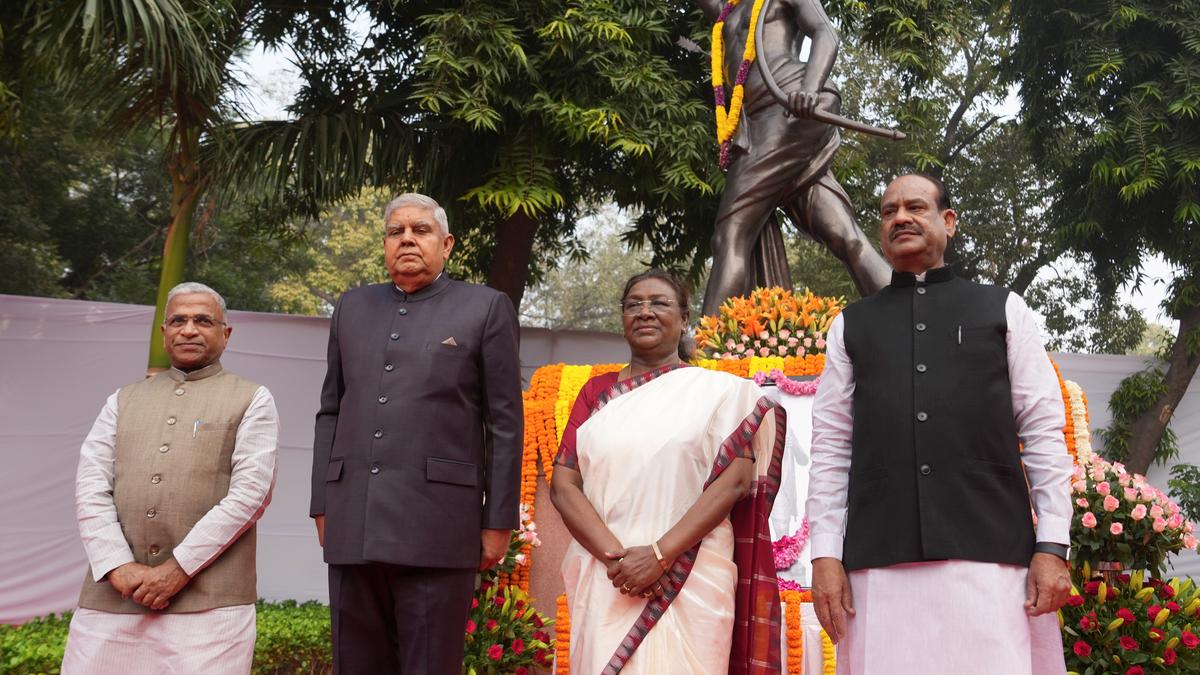
- 16 Nov 2024
In News:
On November 15, 2024, Prime Minister Narendra Modi launched a commemorative stamp and coin to mark the 150th birth anniversary of Birsa Munda, a prominent tribal freedom fighter and leader from Jharkhand.
Key Points about Birsa Munda:
- Iconic Tribal Leader: Birsa Munda, born in 1875, is often referred to as ‘Bhagwan’ (God) and ‘DhartiAaba’ (Father of the Earth) by the tribal communities. He is celebrated for his leadership in the fight against the exploitation of tribal people by both the British and non-tribal settlers.
- Ulgulan Movement: Birsa Munda led the Ulgulan (Great Tumult) against the alienation of land, forced labour, and the illegal appropriation of tribal land in the Chotanagpur Plateau. His efforts were critical in mobilizing tribal communities and challenging the colonial order.
- Religious and Social Reformer: He founded the Birsait faith, focusing on spiritual practices that emphasized prayer, worship of God, and abstaining from alcohol, fostering unity and resilience among tribal communities.
- Death and Legacy: Birsa Munda died in 1900 in British custody at the young age of 25. Despite his early death, his legacy lives on as a symbol of tribal pride and resistance.
- Janjatiya Gaurav Diwas: Since 2021, the Government of India observes November 15 as Janjatiya Gaurav Diwas (Tribal Pride Day) in honor of Birsa Munda's birth anniversary, recognizing the contributions of tribal communities and their role in India's history.
- Highlights of the 2024 Commemoration:
- Commemorative Stamp and Coin: To mark the 150th birth anniversary, the Prime Minister unveiled a commemorative stamp and coin in Bihar's Jamui district. This serves as a tribute to Munda's sacrifices for the country.
- Year-Long Celebrations: The 2024 event marks the beginning of year-long celebrations to commemorate Birsa Munda’s legacy, with a focus on tribal welfare and recognition of their historical contributions.
- Welfare Projects and Initiatives:
- Prime Minister Modi inaugurated and laid the foundation for tribal welfare projects worth over ?6,640 crore.
- The PM launched two tribal freedom fighter museums and tribal research institutes.
- 1.16 lakh homes were sanctioned under the Dharti Aba Janjati Gram Utkarsh Yojana.
- 25,000 homes for Particularly Vulnerable Tribal Groups (PVTGs) were approved under the Pradhan Mantri Janjati Adivasi Nyaya Maha Abhiyan (PM-JANMAN) scheme.
- The launch of 50 mobile medical units aims to improve healthcare access in tribal regions.
- 10 Eklavya Model Residential Schools (EMRS) were inaugurated to promote education for tribal students.
- DhartiAabaJanjatiya Gram Utkarsh Abhiyan:
- The DhartiAabaJanjatiya Gram Utkarsh Abhiyan aims to address gaps in social infrastructure, health, education, and livelihood in tribal-majority villages.
- The initiative is being implemented across 63,000 villages with the involvement of 17 ministries and departments.
- PM-JANMAN Scheme for PVTGs:
- Launched in November 2023, the PM-JANMAN initiative aims to uplift Particularly Vulnerable Tribal Groups (PVTGs) through various interventions like safe housing, clean drinking water, healthcare, education, and sustainable livelihoods. The scheme also supports Van Dhan Vikas Kendras for the trade of forest produce and solar-powered systems for households in tribal areas.
1st Bodoland Mohotsav
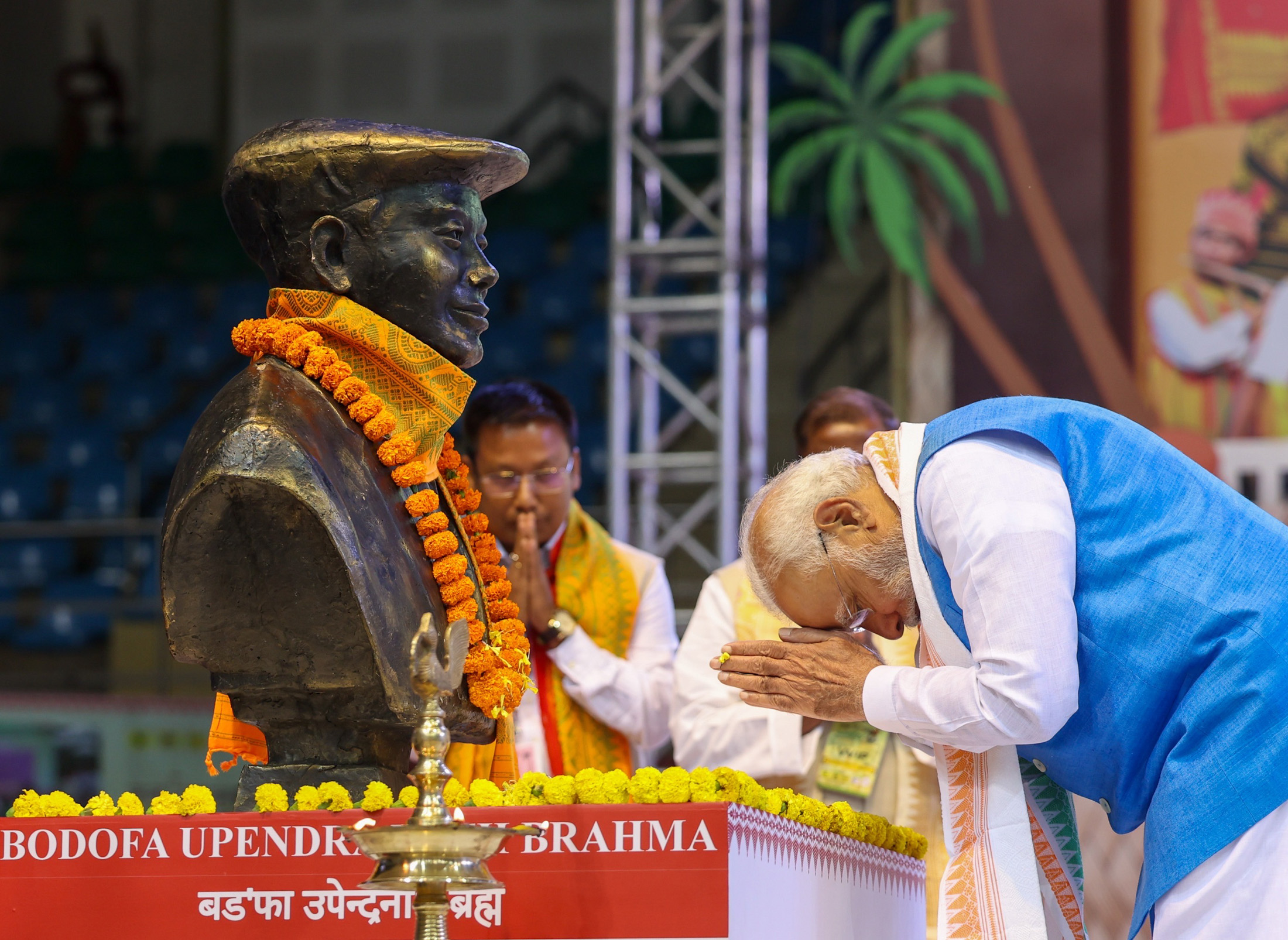
- 16 Nov 2024
In News:
- Recently, Prime Minister Narendra Modi inaugurated the 1st Bodoland Mohotsava two-day event focused on language, literature, and culture.
- Objective: Aims to promote peace, unity, and a vibrant Bodo society through cultural integration. The festival celebrates the rich Bodo culture and heritage.
Historical Context and Peace Initiatives:
- End of Violence: The event marks the end of 50 years of violence, following the Bodo Peace Accord (2020), which ended conflict in Bodoland and led to a path of peace and development.
- Peace Agreements: The Bodo Peace Accord served as a catalyst for other peace settlements, such as the KarbiAnglong Accord, Bru-Reang Accord, and NLFT-Tripura Accord.
Development in Bodoland Post-Peace Accord:
- Impact of the Peace Accord:
- Over 10,000 youth in Assam have renounced violence and joined the mainstream of development.
- Increased mutual trust between the people and the government.
- Economic Assistance:
- Rs 1,500 crore special package by the central government.
- Rs 700 crore spent on infrastructure development in education, health, and culture in Bodoland.
- Rs 5 lakh assistance for families affected by the Bodo conflict.
Government Support for Socio-Economic Development:
- Skill Development & SEED Mission:Focus on skilling, entrepreneurship, employment, and development through the SEED Mission for youth empowerment.
- Rehabilitation of Former Cadres:
- Over 4,000 former cadres of the National Democratic Front of Bodoland (NDFB) have been rehabilitated.
- Many youths have been recruited into Assam Police.
- Tourism & Employment:Growing tourism in Bodoland, with parks like Manas National Park and Raimona National Park, creating employment opportunities for youth.
Cultural Promotion:
- Bodo Culture and GI Tags:Promoting Bodo crafts like Aronnaye, Dokhona, Gamsa, etc., that have received Geographical Indication (GI) tags to preserve cultural identity.
- Bodoland Handloom Mission & Sericulture:Government efforts to promote sericulture and the Bodoland Handloom Mission to sustain Bodo weaving traditions.
- Literary Celebrations:
- Continuous Bodoland Literary Festival in Kokrajhar, enhancing the importance of Bodo literature and language.
- Celebration of Bodo Sahitya Sabha’s 73rd foundation day.
Key Government Initiatives for Development:
- Infrastructure Development:
- Rs 800 crore annually being spent by the Assam government for the development of Bodoland.
- Focus on healthcare, education, and employment.
- Medical Education:Expansion of medical colleges in Assam from 6 to 12, with plans for 12 more new colleges.
PM Vishwakarma Yojana

- 08 Nov 2024
In News:
The PM Vishwakarma Yojana is a landmark initiative by the Indian government aimed at revitalizing traditional craftsmanship and empowering artisans and craftspeople, often referred to as Vishwakarmas. Launched on September 17, 2023, during Vishwakarma Jayanti, the scheme highlights the government's commitment to preserving India's rich cultural heritage and supporting the unorganized sector.
Key Highlights
- Objective:
- To strengthen the Guru-Shishya tradition and improve the quality, reach, and marketability of products and services by artisans.
- To integrate Vishwakarmas into domestic and global value chains, making them self-reliant.
- To alleviate poverty by supporting rural and urban artisans across India.
- Financial Outlay:,Fully funded by the Union Government with a ?13,000 crore budget spanning five years (2023–2028).
- Eligibility:
- Open to rural and urban artisans and craftspeople involved in 18 traditional crafts, such as blacksmithing, goldsmithing, pottery, boat making, and carpentry.
- Covers 5 lakh families in the first year and aims to reach 30 lakh families over five years.
- Key Benefits:
- Financial Support:
- Collateral-free credit of ?1 lakh (first tranche) and ?2 lakh (second tranche) at a concessional 5% interest rate.
- Government provides 8% interest subvention upfront to banks.
- Toolkit Incentive: ?15,000 via e-vouchers for acquiring modern tools.
- Training and Skill Development: Basic and advanced skill training to create industry-ready manpower.
- Digital and Marketing Incentives: Encourages digital transactions and provides marketing support.
- Recognition: Beneficiaries receive a PM Vishwakarma Certificate and ID Card.
- Market Linkage: Facilitates better market access for artisan products.
- Financial Support:
- Achievements (as of Nov 4, 2024):
- 25.8 million applications received.
- 2.37 million artisans registered after verification.
- Over 1 million artisans benefited from toolkit incentives.
Significance
- Promotes inclusive development by supporting an underserved segment of the workforce.
- Recognizes and supports traditional skills passed down through generations, preserving India’s cultural diversity.
- Enhances productivity and competitiveness by integrating artisans into MSME sectors.
- Encourages sustainability through the promotion of handmade, eco-friendly crafts.
Key Institutions Involved
- Ministry of Micro, Small, and Medium Enterprises (MSME): Oversees implementation.
- Common Services Centres (CSC): Facilitates registration through biometric-based PM Vishwakarma Portal.
Challenges Addressed
- Lack of access to modern tools and financial support.
- Insufficient market linkages and exposure for traditional crafts.
- Limited opportunities for skill enhancement and product development.
Maha Kumbh Mela 2025
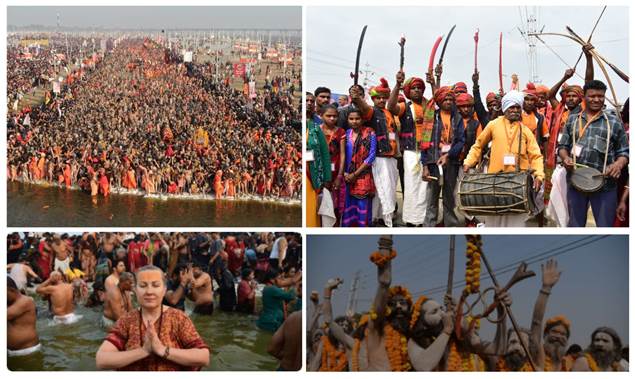
- 07 Nov 2024
In News:
- The Maha Kumbh Mela 2025 will be held in Prayagraj from January 13 to February 26.
- The event is a sacred pilgrimage that draws millions of pilgrims to bathe in the holy waters of the Triveni Sangam (the confluence of the Ganges, Yamuna, and Sarasvati rivers) for spiritual purification and liberation.
Significance and Spiritual Importance
- Sacred Rituals:
- The central ritual is the act of bathing in the holy waters of the confluence, believed to cleanse one’s sins and bring spiritual liberation (Moksha).
- Pilgrims also engage in worship, spiritual discourses, and seek blessings from revered sadhus and saints.
- Auspicious Dates:
- The event includes Shahi Snan (Royal Bath), where prominent saints and their followers bathe on specific dates, marking the beginning of the Mela.
- Paush Purnima marks the start of the auspicious bathing period.
- Cultural Ceremonies:
- The Mela features a grand procession (Peshwai) with Akharas (spiritual orders) on elephants, horses, and chariots.
- Cultural performances, traditional music, dance, and art are also part of the festivities, showcasing India’s vibrant cultural diversity.
Mythological and Historical Roots
- Mythology:
- The Kumbh Mela is deeply embedded in Hindu mythology, symbolizing humanity’s quest for spiritual unity and enlightenment.
- The timing of the event is based on astrological positions of celestial bodies, particularly the Sun, Moon, and Jupiter.
- Historical Significance:
- The origins of the Kumbh Mela trace back over 2,000 years, with references found in the Maurya and Gupta periods.
- Royal Patronage: Emperors like Akbar supported the Mela, symbolizing unity among different religions and cultures.
- British Colonial Era: British officials documented the Mela, fascinated by its scale and ritualistic practices.
- Modern Recognition:
- In 2017, the UNESCO recognized the Kumbh Mela as an Intangible Cultural Heritage of Humanity, underscoring its global significance.
Cultural Celebration and Unity
- Cultural Diversity:
- The Maha Kumbh Mela is a celebration of India's rich cultural heritage, where pilgrims experience traditional crafts, art, music, and dance, alongside spiritual practices.
- International Participation:
- Pilgrims from across the globe attend the Mela, drawn by its message of unity, tolerance, and the universal quest for spiritual growth and peace.
- Message of Unity:
- The Mela serves as a reminder of humanity’s shared desire for self-realization and spiritual fulfillment, transcending national, cultural, and religious boundaries.
First Asian Buddhist Summit in New Delhi
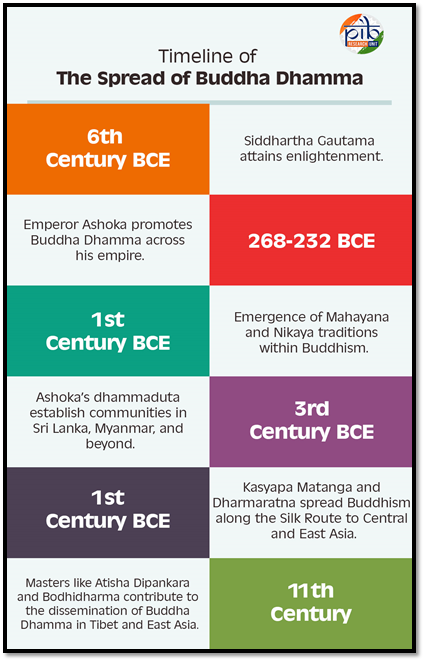
- 04 Nov 2024
In News:
- The Government of India, in partnership with the International Buddhist Confederation (IBC), is hosting the First Asian Buddhist Summit in New Delhi.
- Theme: "Role of Buddha Dhamma in Strengthening Asia."
- Significance: The summit aligns with India’s Act East Policy, focusing on collective, inclusive, and spiritual development across Asia.
- Inauguration: The two-day event will be inaugurated by President Droupadi Murmu on November 5, 2024.
- Participants: Buddhist Sangha leaders, scholars, and practitioners from various Asian Buddhist traditions will gather to promote dialogue, understanding, and address contemporary challenges within the Buddhist community.
Key Themes of the Summit
- Buddhist Art, Architecture, and Heritage
- Focus on preserving and celebrating Buddhist landmarks in India (e.g., Sanchi Stupa, Ajanta Caves).
- Emphasizes the role of Buddhist art in fostering cross-cultural understanding.
- Buddha C?rik? and Dissemination of Buddha Dhamma
- Discusses Buddha’s journeys and how his teachings spread across India and beyond.
- Role of Buddhist Relics in Society
- Relics serve as symbols of Buddha's teachings, promoting devotion, mindfulness, and economic benefits through tourism and pilgrimages.
- Buddha Dhamma in Scientific Research and Well-Being
- Exploration of Buddhist teachings on mindfulness and compassion, and their integration into contemporary scientific practices to enhance well-being.
- Buddhist Literature and Philosophy in the 21st Century
- Delving into timeless Buddhist wisdom that continues to address the human condition, the nature of reality, and paths to enlightenment.
- Exhibition: "India as the Dhamma Setu (Bridge) Connecting Asia," showcasing India's role in the spread of Buddhism and its significance in fostering unity.
India’s Role in Promoting Buddhist Heritage
- Cultural Identity: Buddhism is integral to India's cultural fabric, influencing its national identity and foreign policy.
- Buddhist Tourism Circuit: The Indian government has developed a Buddhist Circuit covering key sites such as Bodh Gaya, Sarnath, and Kapilvastu.
- International Conferences and Symposia: India has hosted several events, including the First Global Buddhist Summit (2023), International Abhidhamma Diwas (2024), and Symposiums on Vipassana Meditation.
- Pali Language Recognition: On October 4, 2024, Pali was granted classical status, recognizing its significance in conveying Buddha’s teachings.
Buddhism’s Influence in Asia
- Historical Context: Buddhism, founded by Siddhartha Gautama in the 6th century BCE, spread across Asia with the support of figures like Emperor Ashoka (268-232 BCE), who promoted peace and harmony through Buddhist teachings.
- Spread of Buddhism: From its origins in India, Buddhism spread to Central Asia, East Asia, and Southeast Asia, adapting to local cultures and creating diverse schools: Theravada, Mahayana, and Vajrayana.
Ningol Chakkouba Festival
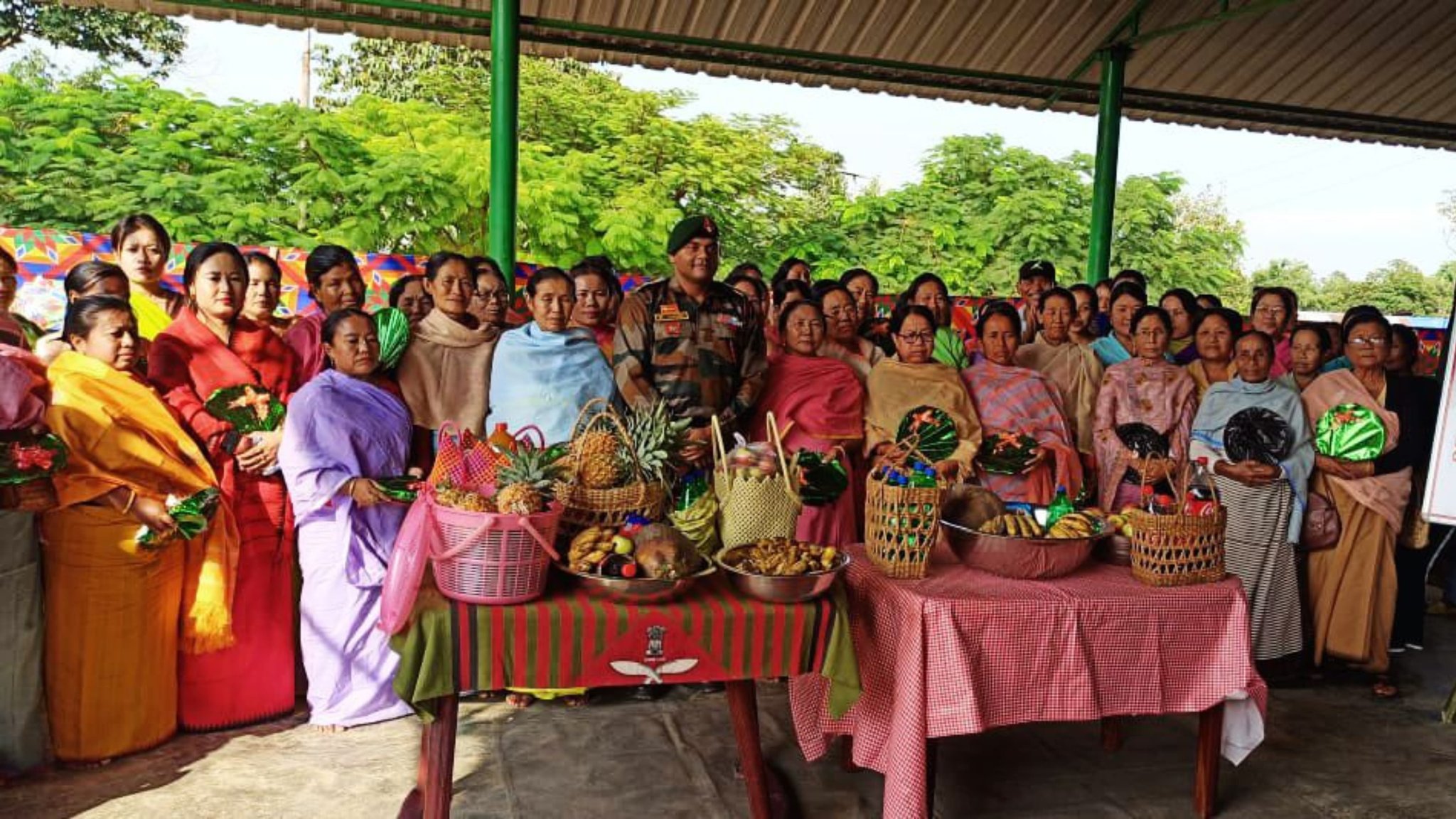
- 04 Nov 2024
In News:
Ningol Chakkouba is one of the biggest festivals of Manipur, primarily celebrated by the Meitei community, but over the years, it has seen participation from various communities.
Key Highlights:
- Date: The festival is celebrated annually on the second day of the lunar month of Hiyangei in the Meitei calendar.
- Main Celebration: The central tradition involves married sisters visiting their maternal homes for a grand feast, joyous reunion, and the exchange of gifts.
- Customary Invitation: A week before the festival, the son of the family formally invites his married sisters to join the celebration.
- Expansion of Celebration: While traditionally celebrated in Manipur, Ningol Chakkouba is now observed in other states and even outside India, where Manipuris are settled.
- Meaning of Ningol Chakkouba:
- Ningol means ‘married woman’.
- Chakouba means ‘invitation for feast’.
- Thus, the festival is a celebration where married women are invited to their parents' home for a special meal.
- Inclusion of Other Communities: Although originally a Meitei tradition, Ningol Chakkouba is now celebrated by various communities due to its emphasis on family reunion, happiness, and promoting peace and harmony in society.
- Cancellation in 2023: The festival was not held in the previous year due to ethnic violence in the state.
Replicas of Konark Wheels at Rashtrapati Bhavan
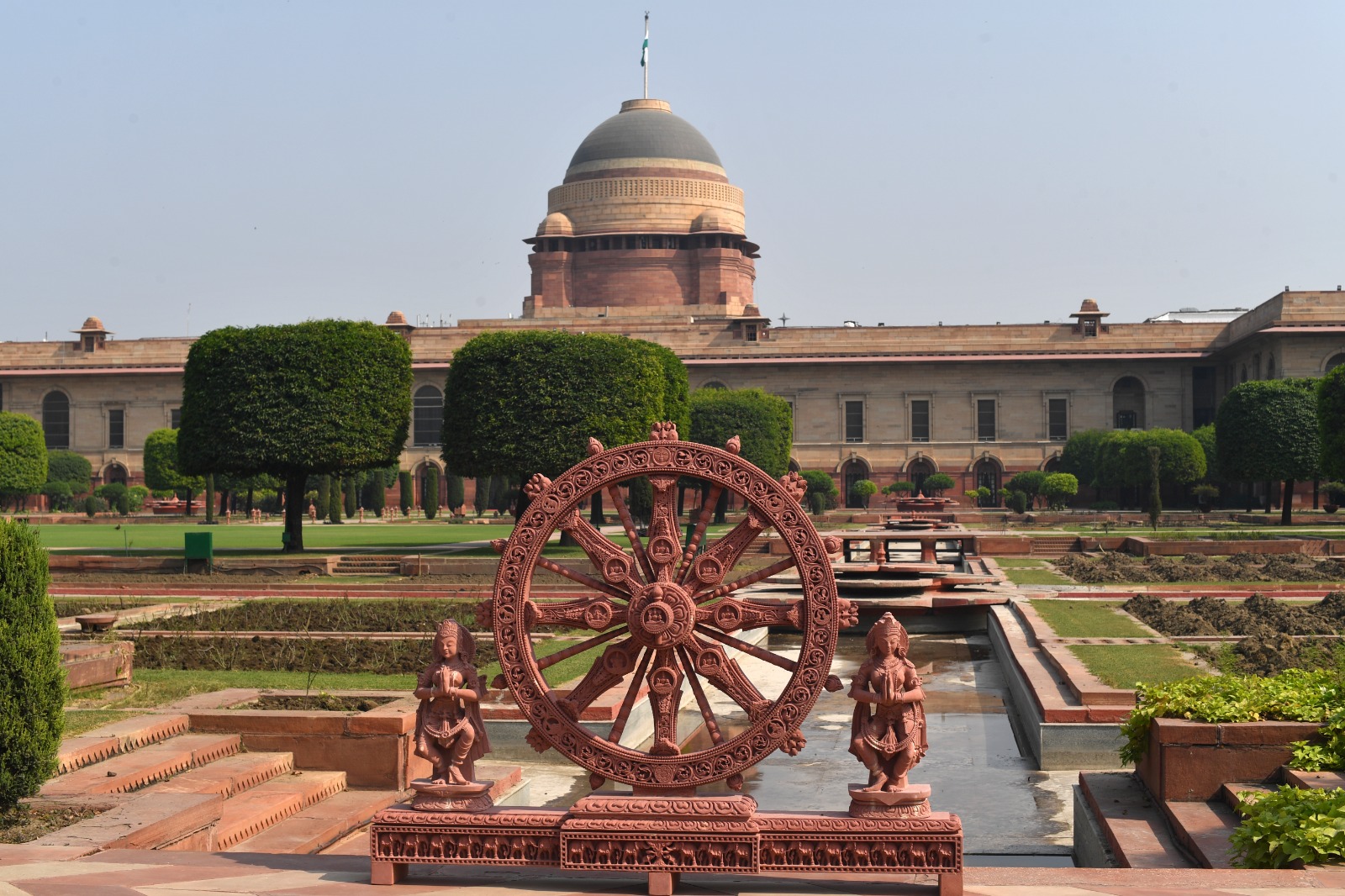
- 30 Oct 2024
In News:
- Four replicas of the Konark wheels, made of sandstone, have been installed at the Rashtrapati Bhavan Cultural Centre and Amrit Udyan.
- This initiative is aimed at showcasing India’s rich cultural heritage and promoting traditional historical elements among visitors to Rashtrapati Bhavan.
Significance of the Konark Sun Temple:
- Historical Background: The Konark Sun Temple was built in the 13th century under King Narasimhadeva I of the Eastern Ganga Dynasty in Konark, Odisha.
- Architectural Design: The temple is a colossal stone chariot with twelve pairs of intricately carved wheels, symbolizing the chariot of the Sun God.
- Materials Used: Constructed using Khondalite stones, the temple features detailed carvings that depict mythology and cultural life.
- Astronomical Significance: The temple's orientation is designed to capture the first light of the sun, reflecting ancient Indian knowledge of astronomy.
- UNESCO World Heritage Status: The Konark Sun Temple was declared a UNESCO World Heritage Site in 1984, recognizing its architectural and historical importance.
Symbolism of the Konark Wheel:
- Time and Progression: The Konark wheel represents time (Kalachakra), progression, and democracy. Its 24 spokes symbolize ancient Indian wisdom and the passage of time.
- Sundial Function: The wheel was historically used as a sundial in the temple, marking the passage of time and symbolizing India’s commitment to progress and resilience.
- National Emblem: The Konark wheel's design is also reflected in the Ashoka Chakra, the wheel on the national flag of India, symbolizing the nation’s resolve towards progress.
Cultural Heritage at Rashtrapati Bhavan:
- The installation of these replicas is part of a broader effort to introduce and promote traditional cultural and historical elements at Rashtrapati Bhavan.
- The Rashtrapati Bhavan Cultural Centre and Amrit Udyan serve as platforms to exhibit India’s diverse artistic legacy to visitors, allowing them to experience the grandeur of ancient Indian architecture and its cultural significance.
National Mission for Manuscripts (NMM)
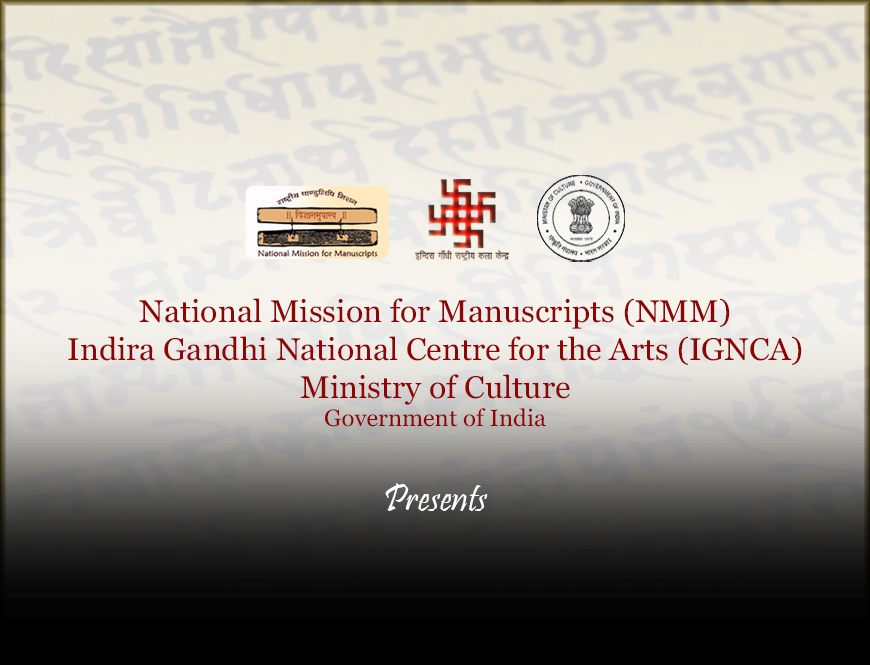
- 26 Oct 2024
In News:
- The Union Ministry of Culture plans to revive and relaunch the National Mission for Manuscripts (NMM) to enhance the preservation and accessibility of India’s ancient texts.
- The mission’s objective is to document, conserve, digitize, and disseminate India’s rich manuscript heritage, ensuring their protection and public access.
Formation of a New Autonomous Body:
- The National Mission for Manuscripts (NMM) is likely to be restructured into an autonomous body called the National Manuscripts Authority, which will be under the Ministry of Tourism and Culture.
- The new body will address the challenges and gaps in manuscript preservation and management, offering more focused and flexible governance.
Background and Achievements:
- Established in 2003, the NMM has been part of the Indira Gandhi National Centre for Arts (IGNCA).
- Key achievements:
- 52 lakh manuscripts have had metadata prepared.
- Over 3 lakh manuscripts have been digitized, though only one-third have been uploaded for public access.
- Preventive and curative conservation of over 9 crore folios of manuscripts has been undertaken over the last 21 years.
- The NMM has set up 100 Manuscripts Resource Centres and Manuscripts Conservation Centres across India.
Current Challenges and Gaps:
- Data Uploading and Access:
- Of the 130,000 digitized manuscripts, only 70,000 are accessible online due to the absence of a comprehensive access policy.
- A significant portion (around 80%) of manuscripts areprivately owned, restricting public access and usage.
- Digitization Mismatch:
- There have been concerns about discrepancies between the digitized data and the original manuscripts, which requires correction to ensure authenticity and accuracy.
- Lack of Comprehensive Access Policy:
- Limited public access to manuscripts due to policy restrictions hinders further research and public engagement with this rich heritage.
Scope and Future of NMM:
- India's Manuscript Heritage: India is believed to have around 10 million manuscripts, spread across various regions, languages, scripts, and topics.
- Digitization and Accessibility: Moving forward, the key challenge will be ensuring that a larger proportion of the manuscripts are digitized, uploaded, and made publicly available, particularly from private collections.
- The establishment of the National Manuscripts Authority is expected to streamline efforts and enhance coordination between government bodies, private institutions, and scholars.
2nd Indian Lighthouse Festival
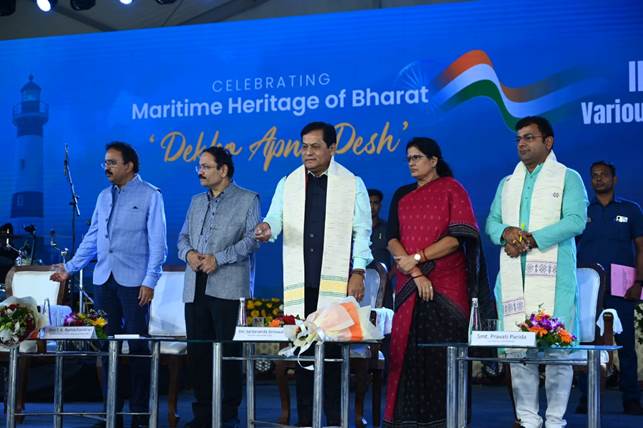
- 20 Oct 2024
In News:
The 2nd Indian Lighthouse Festival was held with the aim of promoting lighthouse tourism and celebrating India’s maritime legacy.
Strategic Importance of the Lighthouse Projects
- The Ministry of Ports, Shipping & Waterways (MoPSW) has invested significantly in developing lighthouses as tourist hubs. The festival marks a concerted effort to integrate tourism with the preservation of these iconic structures.
- Lighthouse tourism has witnessed a remarkable increase of over 400% in visitor numbers since 2014, as part of India's broader vision to promote the blue economy.
-
- From just 4 lakh visitors in 2014, the footfall surged to 16 lakh in 2023-24, with over 9 lakh tourists already in the first half of FY 2024-25.
-
Key Projects and Announcements at the Festival
- New Lighthouses: The announcement of the two new lighthouses at Chaumuck and Dhamra along Odisha’s coastline is significant for enhancing coastal infrastructure and promoting maritime tourism in the state.
- Kalwan Reef Lighthouse: Located in Jamnagar, Gujarat, this lighthouse is part of a broader effort to enhance maritime navigation and heritage conservation along India’s western coastline.
- Development of Coastal Communities: Highlighted the importance of empowering coastal communities, particularly those living around lighthouses, to preserve and promote these structures as national cultural icons. These communities are expected to play a crucial role in lighthouse preservation, as well as in tourism and local economic development.
- Paradip Port Initiatives: Additionally, major infrastructure projects at Paradip Port, such as a stacker-cum-reclaimer and a flyover bridge, were inaugurated to further bolster the port’s capabilities and enhance its role in maritime logistics. The Sagarmala Programme also continues to transform Paradip Port into a mega port with a projected handling capacity of 500 MTPA by 2047.
Economic and Employment Impact
The development of 75 iconic lighthouses across 9 coastal states and one Union Territory is not only aimed at tourism development but also focuses on job creation. As of 2024:
- More than 150 direct jobs and 500 indirect jobs have been created in sectors such as hospitality, transportation, and local crafts, driven by the increasing footfall at these tourist destinations.
- The creation of modern amenities at these lighthouses, such as museums, amphitheaters, and children’s parks, has helped in transforming lighthouses into multifaceted tourism hubs that attract both domestic and international tourists.
Collaborative Efforts for Preservation and Promotion
- Public-Private Partnerships (PPP): Encouraging collaboration between the government, local communities, and private stakeholders to develop and maintain lighthouses as sustainable tourist destinations.
- National Framework: A central association will be created to manage coastal societies surrounding lighthouses, enabling local communities to actively participate in their preservation, protection, and promotion.
- Cultural Integration: The event also underscored the need for integrating cultural heritage with tourism development, using the lighthouses as platforms to showcase local art, cuisine, and history.
International Abhidhamma Divas
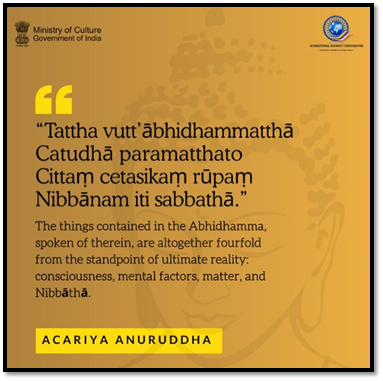
- 16 Oct 2024
In News:
Recently, International Abhidhamma Divas was celebrated at Vigyan Bhavan, New Delhi, with PM Narendra Modi.
Key Details:
- India's Spiritual Legacy: Birthplace of Buddhism; site of Gautam Buddha's enlightenment.
- Sacred Sites: Veneration of locations like Bodh Gaya, symbolizing Buddha's journey and teachings.
- Core Teachings: Abhidhamma as a key philosophical component emphasizing mental discipline and self-awareness.
International Abhidhamma Divas
- Global Observation: Celebrates the significance of Abhidhamma in ethical conduct and mindfulness.
- Cultural Connection: Highlights India's role in preserving Buddhism and bridging ancient wisdom with contemporary practices.
Historical Background and Significance
- Commemoration: Marks Buddha’s descent from T?vati?sa to Sankassiya (Sankisa Basantapur).
- Teaching Period: Buddha taught the Abhidhamma to deities for three months; linked to the end of the Rainy Retreat and the Pav?ra?? festival.
Teachings of Abhidhamma
- Systematic Analysis: Provides a detailed exploration of mind and matter, differing from Sutta Pi?aka.
- Specialized Vocabulary: Key terms include "citta" (consciousness), "cetasika" (mental factors), "r?pa" (materiality), and "nibb?na" (liberation).
- Textual Framework: Six core books of Abhidhamma Piñaka cover moral states, aggregates, and causal relationships.
- Key Treatise: The Paññh?na offers in-depth causal analysis, essential for practitioners’ understanding.
Modern Observance and Celebrations
- Significance of Pali: Recognition of Pali as a classical language; promoting India's Buddhist heritage.
- Participants: Gathering of ambassadors, monks, scholars from 14 countries; emphasizes Abhidhamma's relevance today.
- Program Highlights: Dhamma discourse, academic sessions on Abhidhamma’s significance, exhibitions on Pali's evolution and Buddha's teachings.
Classical Status of Pali Language
- Pali's Role: Sacred language for delivering Buddha's teachings; recognized as a Classical Language by India.
- Buddhist Canon: Major texts include the Tipitaka (Vinaya, Sutta, Abhidhamma Pitaka) and commentarial traditions.
- Literary Heritage: Jataka Kathas reflect shared moral values; status enhances Pali studies in education and research.
Significance
- Significance of Celebration: Abhidhamma Divas underscores efforts to preserve and promote Buddhism’s legacy.
- Revitalization of Buddhism: Fosters global engagement and appreciation for Buddha’s teachings, reaffirming India's role in Buddhist studies.
Doddalathur Megalithic Burial Site
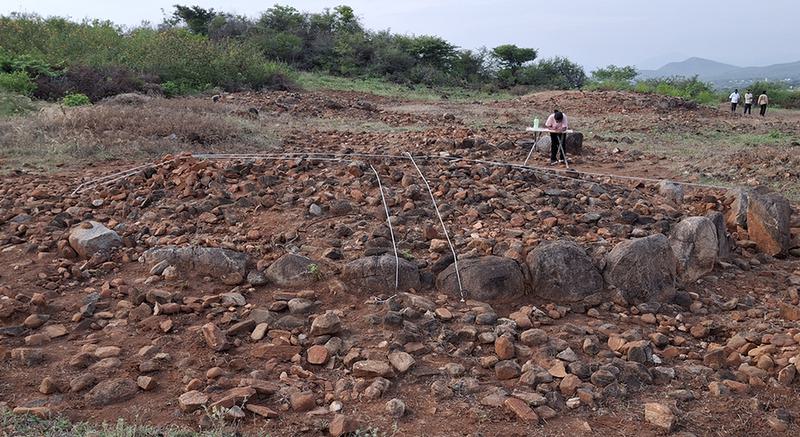
- 07 Oct 2024
In News:
A team of history and archaeology scholars and students from the University of Mysore have embarked on an excavation of megalithic burial sites in Chamarajanagar district.
- Location: Doddalathur village, Hanur taluk, Chamarajanagar district, situated in a valley by the Male Mahadeshwara Hill ranges.
- Team: A group of history and archaeology scholars and students from the University of Mysore, in collaboration with the Mythic Society, Bengaluru.
- Excavation Focus: Exploration of megalithic burial sites corresponding to the Iron Age (approximately 1200 BC to 300 CE).
- Site Features:
- Burials consist of circles made of large boulders, referred to as "megalithic."
- A small hillock is located to the west of the village.
- Historical Significance:
- The site was discovered by C. Krishnamurti of the Archaeological Survey of India in 1961.
- Originally contained over 1,000 burials, many of which have been lost due to agricultural expansion and development.
- Despite disturbances, many burials remain intact and are considered suitable for excavation.
- Goals of the Project:
- To enhance understanding of megalithic-Iron Age culture in southern Karnataka's hilly regions.
- To provide practical field training for archaeology students.
Status of Classical Language: An Explainer
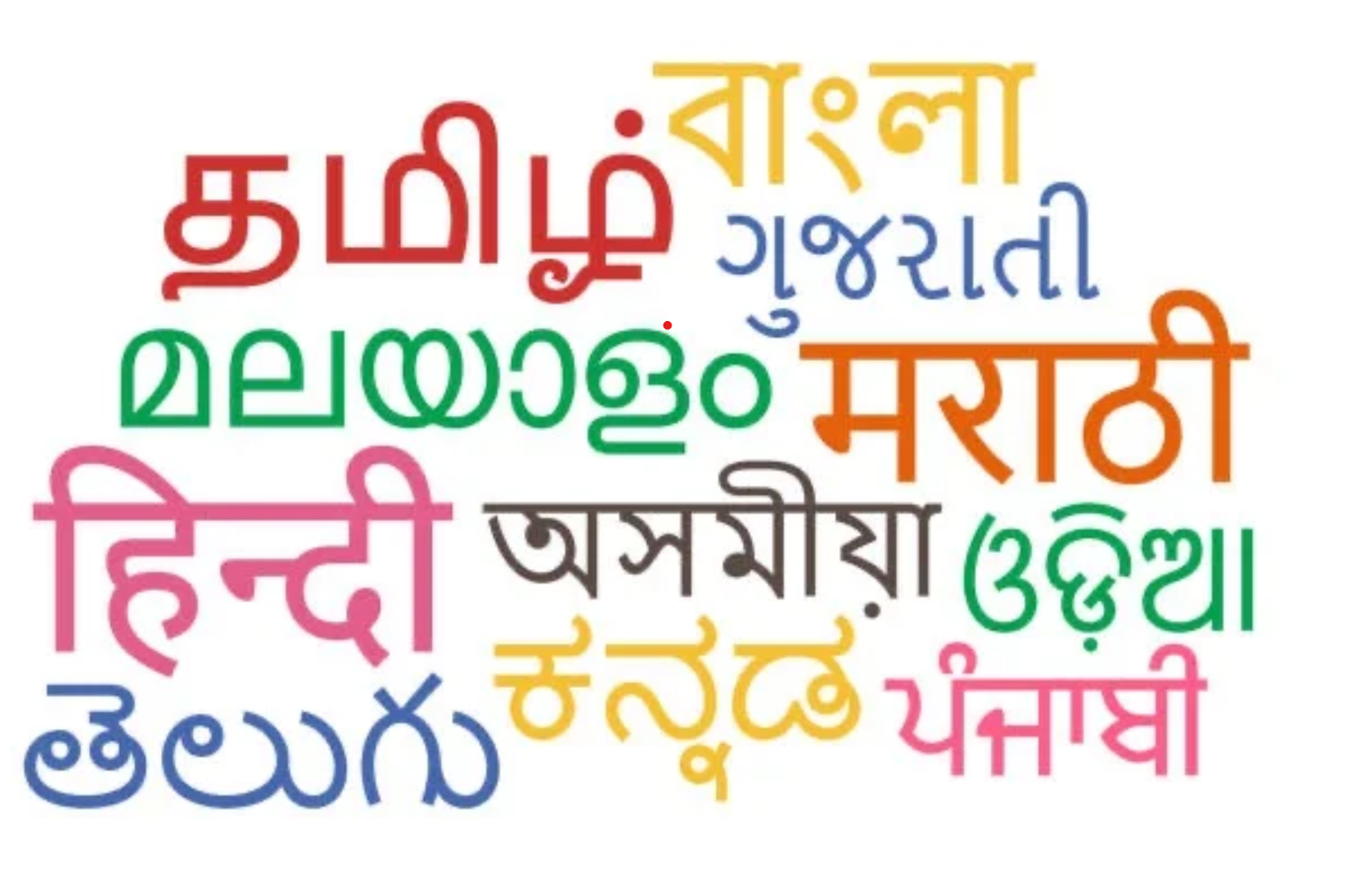
- 04 Oct 2024
In News:
The Union Cabinet has approved to confer the status of Classical Language to Marathi, Pali, Prakrit, Assamese and Bengali languages.
Why is a language declared as Classical?
Designating a language as classical acknowledges its historical significance and its role in preserving Bharat’s rich cultural heritage. These languages have been crucial in transmitting ancient knowledge, philosophies, and values for millennia. Government recognition emphasizes their deep antiquity and literary traditions, enhancing their status and promoting efforts for their preservation and research, ensuring their relevance in the modern world.
What are the criteria for declaring a language as classical?
In 2004, the Government of India, for the first time, created a new category of languages known as Classical Languages. It set the following as criteria for the status of Classical Language:
- High antiquity of its early texts/ recorded history over a thousand years.
- A body of ancient literature/ texts, which is considered a valuable heritage by generation of speakers.
- The literary tradition must be original and not borrowed from another speech community.
This criterion was revised in 2005 and 2024 based on the recommendations of Linguistic Experts Committees (LEC) under Sahitya Akademi to examine the proposed languages for the status of Classical Language. Later the criteria were revised in 2024 as follows:
- High antiquity of its early texts/recorded history over a period of 1500- 2000 years.
- A body of ancient literature/texts, which is considered a heritage by generations of speakers.
- Knowledge texts, especially prose texts in addition to poetry, epigraphical and inscriptional evidence.
- The Classical Languages and literature could be distinct from its current form or could be discontinuous with later forms of its offshoots.
The 2024 Linguistic Expert Committee also recommended the following languages to be fulfilling revised criteria to be considered as a Classical Language: Marathi, Pali, Prakrit, Assamese, Bengali
How many languages have been declared classical so far?
Languages Date of Recognition Notification by Source/Notification Date
Tamil October 12, 2004 Ministry of Home Affairs October 12, 2004
Ministry of Sanskrit November 25, 2005 Ministry of Home Affairs November 25, 2005
Telugu October 31, 2008 Ministry of Culture October 31, 2008
Kannada October 31, 2008 Ministry of Culture October 31, 2008
Malayalam August 8, 2013 Ministry of Culture August 8, 2013
Odia March 1, 2014 Ministry of Culture March 1, 2014
Steps Taken by the Ministry of Education for Advancing Classical Languages:
- Establishment of Central Universities (2020): Three universities created to promote Sanskrit through an Act of Parliament.
- Central Institute of Classical Tamil:
- Facilitates translation of ancient Tamil texts.
- Promotes research and offers courses for students and scholars.
- Centres for Excellence:
- Established for Classical Kannada, Telugu, Malayalam, and Odia under the Central Institute of Indian Languages in Mysuru.
- Awards: Introduction of national and international awards to recognize achievements in Classical Languages.
- Additional Benefits:
- National Awards for Classical Languages.
- Establishment of university chairs.
- Dedicated centers for promoting Classical Languages.
Thanjavur Veena
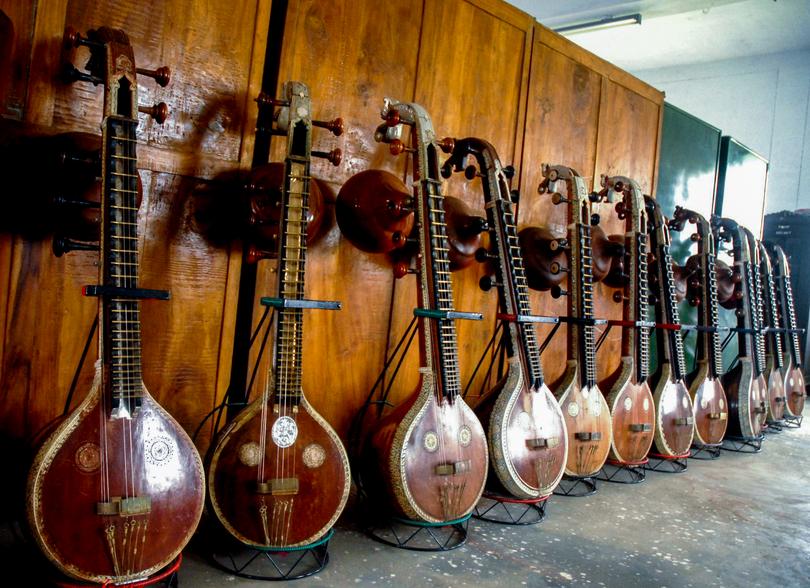
- 03 Sep 2024
In News:
The Thanjavur Veena has the distinction of being the first musical instrument in India to receive the Geographical Indication (GI) tag, highlighting its cultural and artistic significance. Here’s an overview of its features, types, and craftsmanship:
About Thanjavur Veena
- Construction:
- The Thanjavur Veena is known for its unique construction, which comes in two main types:
- Ekantha Veena: Carved from a single block of wood.
- Sada Veena: Composed of three sections—resonator (kudam), neck (dandi), and head—with joints.
- The Thanjavur Veena is known for its unique construction, which comes in two main types:
- Design Features:
- The instrument features 24 fixed frets (mettu), enabling musicians to play a wide range of ragas.
- Traditionally made from the bark of the Jackfruit tree, the bark undergoes extensive testing to ensure quality and durability.
- Craftsmanship:
- The process of crafting a Thanjavur Veena can take 15-20 days, involving cutting, intricate carving, shaping, and assembly of the wood to form the integral parts of the instrument.
Types of Veena
The Thanjavur Veena is one of several types of veenas used in Indian classical music:
- Rudra Veena and Vichitra Veena: Predominantly used in Hindustani classical music.
- Saraswati Veena and Chitra Veena: Associated with Carnatic classical music, with the Saraswati Veena being unique to Thanjavur.
Cultural Significance
- The Saraswati Veena is particularly notable as it is often associated with Goddess Saraswati, the deity of learning and arts, who is frequently depicted holding a veena. This connection emphasizes the instrument's importance in Indian culture and music.
100 Years of the Discovery of the Indus Civilization
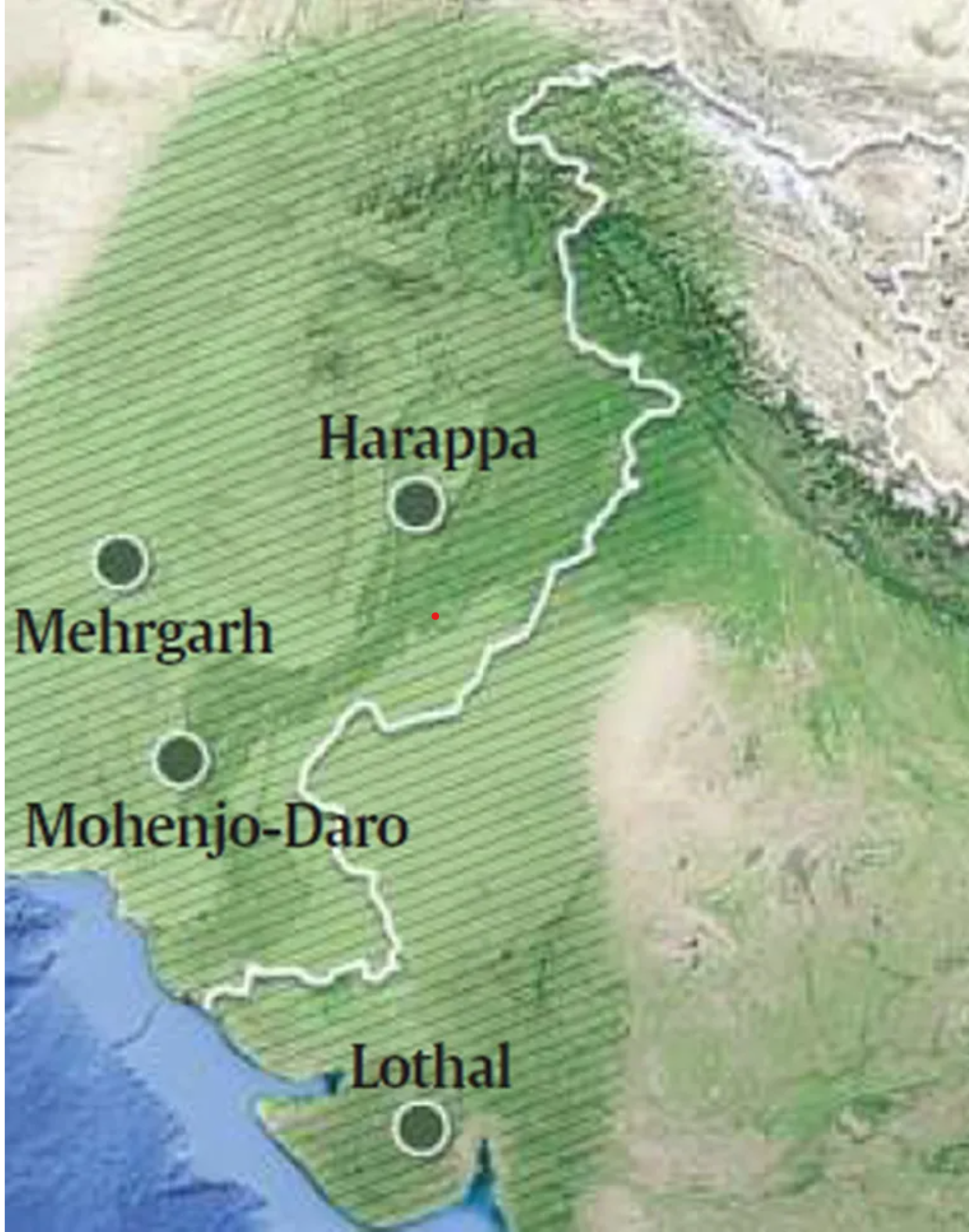
- 22 Sep 2024
Introduction
The centenary of the announcement of the Indus Valley Civilization (IVC) by Sir John Marshall on September 20, 1924, marks a significant milestone in archaeological history. This civilization, known for its advanced urban planning, encompasses over 2,000 sites across India, Pakistan, and Afghanistan.
Historical Context
Discovery of the Indus Civilization
- John Marshall's Role: As the Director-General of the Archaeological Survey of India (ASI), Marshall played a pivotal role in the excavations of Harappa and Mohenjodaro.
- Initial Findings: The civilization was revealed through meticulous work over two decades, beginning with Marshall's initial interest in the antiquities of India.
The Process of Discovery
The Concept of 'The Slow Hunch'
- Definition: Inspired by Steven Johnson's idea of 'the slow hunch,' this concept highlights how insights develop over time, similar to Joseph Priestley's early experiments with oxygen.
- Application to Marshall: Marshall's initial curiosity about the antiquity of India was nurtured through years of observations and explorations, culminating in the excavation of Harappa in 1921.
Key Individuals Involved
- Daya Ram Sahni: Conducted the first excavations at Harappa, uncovering evidence of an ancient culture.
- Rakhaldas Banerji: Excavated Mohenjodaro in 1922, leading to significant discoveries that indicated a widespread civilization.
Institutional Challenges
Limitations within ASI
- Lack of Collaboration: The ASI lacked a platform for archaeologists to share insights, impeding a collaborative approach to discoveries.
- Marshall's Focus: His dedication to ongoing projects, particularly at Taxila, resulted in delays in recognizing the significance of findings at Harappa and Mohenjodaro.
Announcing the Discovery
Marshall's Publication
- Impactful Presentation: In September 1924, Marshall's article vividly described the architectural and cultural features of the Indus Civilization, captivating readers.
- Scholarly Reception: The discovery sparked immediate scholarly interest, leading to further inquiries into the civilization's connections with ancient Mesopotamia.
Characteristics of the Harappan Civilization
Overview
- Timeframe: Flourished around 2500 BCE, classified as a Bronze-age civilization.
- Major Sites: Notable locations include Harappa, Mohenjodaro, and Lothal.
Key Features
- Urban Planning: Cities featured grid layouts, advanced drainage systems, and distinct public and private spaces.
- Agriculture and Economy: The economy thrived on agriculture, trade, and crafts, with evidence of cotton production and extensive trade networks.
Religious Practices
- Deities and Symbols: Terracotta figurines and seals indicate worship of fertility deities and animal figures, suggesting a rich spiritual life.
Reasons for Decline
Theories of Collapse
- Environmental Changes: Shifts in rainfall and tectonic activity may have disrupted agriculture and led to resource scarcity.
- Invasion Theories: While some suggest Indo-European invasions, evidence of cultural continuity challenges this narrative.
Recent Initiatives
Preservation and Promotion
- National Maritime Heritage Complex: Development at Lothal aims to highlight maritime history and attract tourism.
- UNESCO Recognition: Dholavira was added to the World Heritage list in 2021, showcasing the importance of IVC sites.
Union Budget 2024-25: Corridor Projects for Bihar's Temples
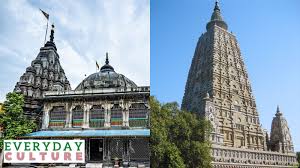
- 18 Sep 2024
Why in News?
The Union Budget 2024-25 announced plans to develop corridor projects for the Vishnupad Temple at Gaya and the Mahabodhi Temple at Bodh Gaya in Bihar. These initiatives aim to enhance both temples as significant pilgrimage and tourist destinations, modeled after the successful Kashi Vishwanath Corridor. The temples are located approximately 10 kilometers apart and hold considerable cultural significance.
Key Facts About the Temples
Vishnupad Temple at Gaya
- Location: Situated on the banks of the Phalgu/Falgu River in Gaya district, Bihar.
- Deity: Dedicated to Lord Vishnu.
- Legend: Local mythology recounts that a demon named Gayasur sought the power to help others attain moksha (liberation). After misusing this power, he was subdued by Lord Vishnu, who left a footprint at the temple, symbolizing this event.
- Architectural Features: The temple stands about 100 feet tall and is supported by 44 pillars made from large gray granite blocks (Munger Black stone), joined with iron clamps. The octagonal shrine is oriented towards the east.
- Construction: Built in 1787 under Queen Ahilyabai Holkar's orders.
- Cultural Practices: The temple is especially significant during Pitra Paksha, a time for honoring ancestors, attracting many devotees. The Brahma Kalpit Brahmins, or Gayawal Brahmins, have served as traditional priests since ancient times.
Mahabodhi Temple at Bodh Gaya
- Historical Significance: Believed to be the location where Gautam Buddha attained enlightenment under the Mahabodhi Tree.
- Construction: Originally built by Emperor Ashoka in the 3rd century BC, with the current structure dating back to the 5th–6th centuries.
- Architectural Features: The temple complex includes the 50-meter-high Vajrasana (the Diamond Throne), the sacred Bodhi Tree, and six other sacred sites associated with Buddha's enlightenment. The site is surrounded by numerous ancient Votive stupas and is protected by circular boundaries.
- Sacred Sites:
- Bodhi Tree: A direct descendant of the original tree under which Buddha attained enlightenment.
- Animeshlochan Chaitya: Where Buddha spent the second week of meditation post-enlightenment.
- Ratnachakrama: Site of Buddha's third week after enlightenment.
- Ratnaghar Chaitya: Site of Buddha's fourth week after enlightenment.
- Ajapala Nigrodh Tree: Site of Buddha’s fifth week after enlightenment.
- Lotus Pond: Site of Buddha’s sixth week after enlightenment.
- Rajyatana Tree: Site of Buddha’s seventh week after enlightenment.
- Recognition: Designated a UNESCO World Heritage Site in 2002, the Mahabodhi Temple attracts numerous national and international pilgrims, emphasizing its spiritual importance.
Other Tourist Attractions in Bihar
Additional notable tourist sites in Bihar include:
- Vishwa Shanti Stupa in Rajgir
- Nalanda
- Ancient city of Patliputra
- Valmiki Nagar Tiger Reserve in West Champaran
What is the Pilgrim Corridor Project (PCP)?
The Pilgrim Corridor Project (PCP) aims to upgrade religious sites into world-class destinations for spiritual and tourism purposes.
Battle of Saragarhi
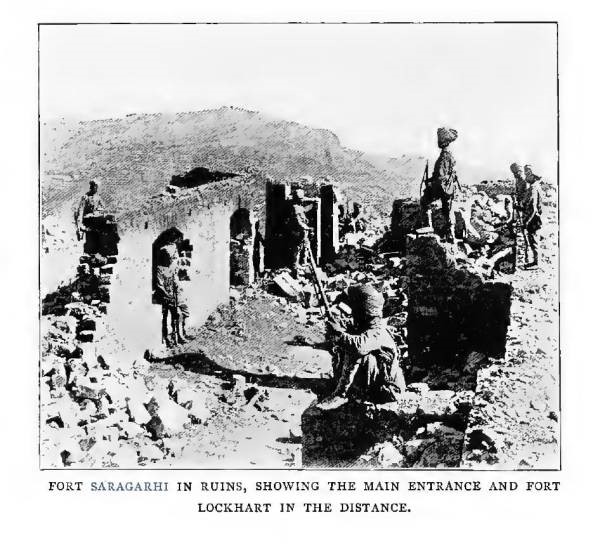
- 13 Sep 2024
Why September 12 is Observed as Saragarhi Day:
- Historical Significance: The Battle of Saragarhi is considered one of the finest last stands in military history. On September 12, 1897, 21 soldiers of the 36th Sikh Regiment (now 4 Sikh) defended the fort against 8,000 Orakzai and Afridi tribal militants.
- 127th Anniversary: September 12 marks the 127th anniversary of this battle, which is now regarded as a legendary stand in global military history.
- The Battle: The 21 soldiers held the fort for seven hours despite being heavily outnumbered. They killed 200 militants and injured 600 before they were overwhelmed.
- Capt Amarinder Singh’s Account: In his book, he notes that the soldiers were aware of their certain death but chose to fight valiantly without surrendering, demonstrating unparalleled bravery.
What was Saragarhi and its Importance:
- Location and Role: Saragarhi was a communication tower between Fort Lockhart and Fort Gulistan in the North West Frontier Province (now Pakistan). It was crucial for linking these two forts, which housed a large number of British troops.
- Manning of Saragarhi: On that day, it was manned by only 21 soldiers from the 36th Sikh Regiment and a non-combatant, Daad, who performed odd jobs for the troops.
Details of the Battle:
- Initial Encounter: Around 9 am, the sentry spotted a large tribal army approaching, estimated between 8,000 and 15,000 strong.
- Communication: Sepoy Gurmukh Singh sent a Morse code message to Lt Col Houghton, requesting reinforcements. The response was to hold the position, as the supply route had been cut off.
- Challenges: The soldiers faced being outnumbered, limited ammunition (about 400 rounds per man), and communication issues. Sepoy Gurmukh Singh managed all heliograph communication tasks alone.
Key Figures:
- Havildar Ishar Singh: Leader of the defending troops, known for his bravery and independent nature. He was a respected and loved figure in his regiment.
- Sepoy Gurmukh Singh: The signalman who maintained communication during the battle, despite overwhelming challenges.
- Daad: The non-combatant who fought alongside the soldiers and killed five militants before being killed himself.
Recognition and Legacy:
- British Recognition: Queen Victoria awarded the 21 deceased soldiers the Indian Order of Merit (equivalent to the Victoria Cross), along with two ‘marabas’ (50 acres) and Rs 500 each.
- Current Observance: In 2017, the Punjab government declared September 12 as Saragarhi Day.
- Memorials: The Khyber Scouts regiment of the Pakistani army still mounts a guard at the Saragarhi memorial. The British built an obelisk with bricks from Saragarhi and commissioned gurdwaras at Amritsar and Ferozepur in honor of the martyrs. Shiromani Gurudwara Parbandhak Committee has named a hall after Saragarhi.
- Cultural Impact: The Battle of Saragarhi has inspired various media portrayals, including Akshay Kumar’s film Kesari.
Mangal Pandey
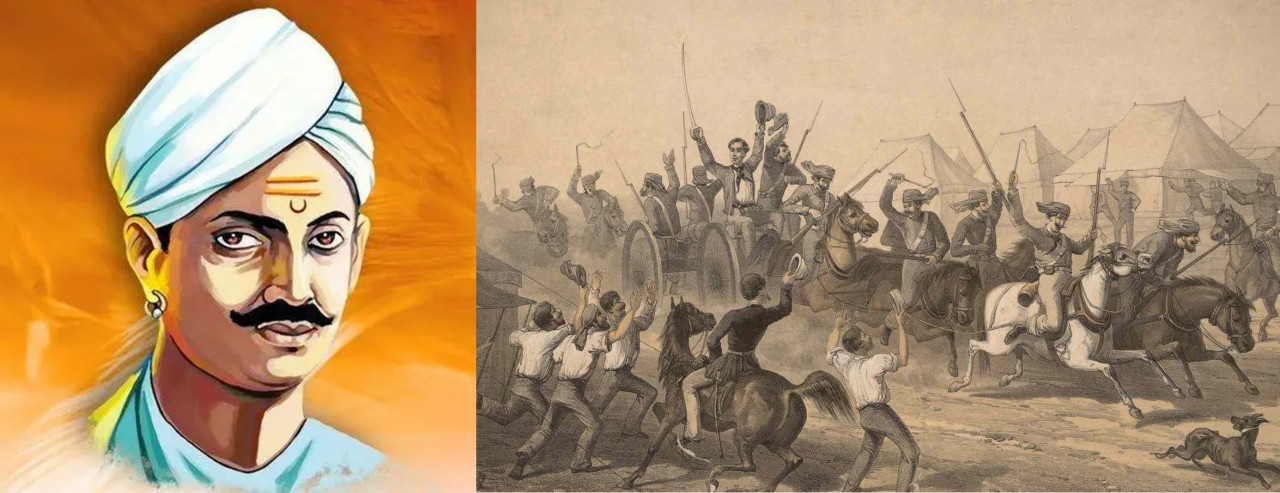
- 09 Apr 2024
Why is it in the News?
Sepoy Mangal Pandey likely didn't anticipate that his shot at the Sergeant Major of his regiment near Kolkata on March 29, 1857, would ignite a significant event in Modern Indian history—the Revolt of 1857, also known as the Sepoy Mutiny or the First War of Indian Independence.
Who was Mangal Pandey?
- Mangal Pandey was a prominent historical figure who played a pivotal role in India's struggle for independence from British colonial rule.
- Born in the kingdom of Awadh, which contributed significantly to the East India Company's army, Mangal Pandey joined the 34th Bengal Native Infantry at the age of 22.
Annexation of Awadh:
- In 1856, the British annexed Awadh in a treacherous act that provoked widespread anger and resentment among the local population.
- The deposition of the Nawab and the subsequent confiscation of villages from the taluqdars during the land revenue settlement of 1856 only exacerbated the situation.
Mangal Pandey's Mutiny and Execution:
- The introduction of the Enfield rifle, which used animal fat (beef and pork) in its cartridges, was met with fierce resistance from soldiers like Mangal Pandey.
- They perceived the use of these cartridges as a direct affront to their religious beliefs.
- On March 29, 1857, Mangal Pandey openly revolted, firing at his Senior Sergeant Major in protest.
- His act of defiance led to his capture, and he was subsequently hanged by order of a Court Martial at Lal Bagan in Barrackpore.
- Mangal Pandey's sacrifice and bravery in the face of British oppression have earned him a lasting place in India's history as a symbol of resistance against colonial tyranny.
The Expansion of the 1857 Revolt and Its Lasting Impact:
- The bravery exhibited by Mangal Pandey inspired a wave of resistance among other soldiers, notably those of the 7th Awadh Regiment.
- On May 11, 1857, a group of Sepoys from Meerut refused to use the new cartridges and killed their European officers, marching to the Red Fort in an act of defiance.
The Legacy of the 1857 Revolt:
- The revolt of 1857 had far-reaching consequences and reshaped the dynamics of British rule in India.
- In response to the growing unrest, the British Parliament passed the Government of India Act in 1858, effectively transferring all powers of the East India Company to the Crown.
- Queen Victoria was subsequently declared the Sovereign of British India.
- The Queen's Proclamation, announced by Lord Canning in 1858, introduced a new policy of perpetual support for the native Princes and pledged non-intervention in matters of religious beliefs in India.
- This policy was further reinforced in 1877 during the Delhi Durbar, where Queen Victoria assumed the title of Qaiser-e-Hind, reflecting her position as the Empress of India.
- The 1857 revolt, sparked by Mangal Pandey's actions, marked a turning point in India's struggle for independence and continues to be remembered as a pivotal moment in the nation's history.
Rakhigarhi
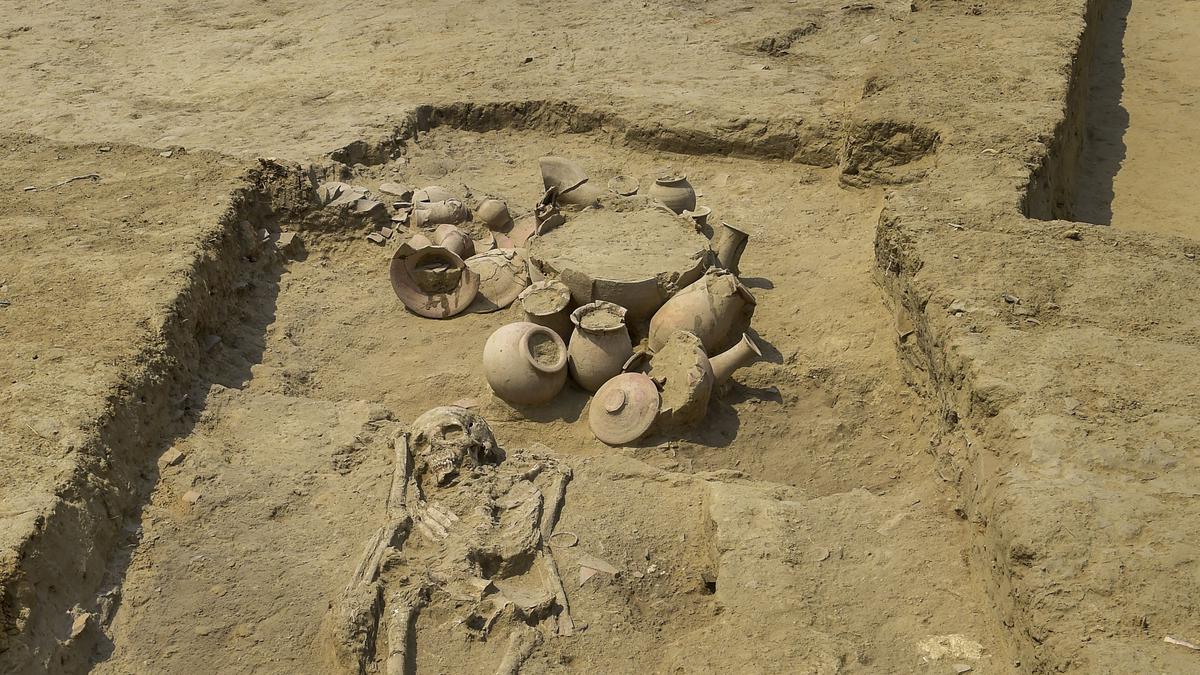
- 06 Apr 2024
Why is it in the News?
The NCERT has proposed updates to school textbooks, including adding findings from DNA analysis of skeletal remains at the Rakhigarhi archaeological site in Haryana and removing references to the Narmada Dam project's impact on tribals, leading to displacement and destitution.
About the Ancient Site of Rakhigarhi:
- The site of Rakhigarhi is one of the five known biggest townships of the Harappan civilization on the Indian subcontinent.
- The other four are:
- Harappa
- Mohenjodaro and Ganveriwala in Pakistan and
- Dholavira (Gujrat) in India
- Five interconnected mounds spread over a huge area from the Rakhigarhi's unique site.
- Two mounds, out of five, were thickly populated.
- This site was excavated by Shri Amarendra Nath of Archeological Survey of India.
- The archaeological excavations revealed a mature Harappan phase represented by a planned township having mud-brick as well as burnt-brick houses with proper drainage systems.
- The ceramic industry is represented by redware, which includes dish-on-stands, vases, jars, bowls, beakers, perforated jars, goblets, and hands.
- Animal sacrificial pits lined with mud brick and triangular and circular fire alters on the mud floor have also been excavated signifying the ritual system of Harappans.
- A cylindrical seal with five Harappan characters on one side and a symbol of an alligator on the other is an important find from this site.
- Other antiquities included blades; terracotta and shell bangles; beads of semiprecious stones, terracotta, shell, and copper objects; animal figurines, toy cart frame and wheel of terracotta; bone points; inscribed steatite seals and sealings.
- The excavations have yielded a few extended burials, which certainly belong to a very late stage, maybe the medieval times.
About Harappan Civilization:
- The Harappan civilization is believed to be one of the oldest world civilizations together with Egypt and Mesopotamia.
- It flourished around 2,500 BC, in the western part of South Asia, in contemporary Pakistan and Western India.
- The Harappan civilization developed along the mighty river, the Indus, and for that reason, it is also known as the Indus Valley Civilization.
- The Harappan civilization is identified as a Bronze-age civilization because many objects have been found that are made up of copper-based alloys.
- For example, the famous ‘dancing girl,’ a bronze figurine that provides an insight into the advances made in art and metallurgy, as well as the hairstyle and ornaments prevalent during the period.
- In the 1920s, the Archaeological Department of India carried out excavations in the Indus Valley wherein the ruins of the two old cities, viz. Mohenjodaro and Harappa were unearthed.
Usha Mehta
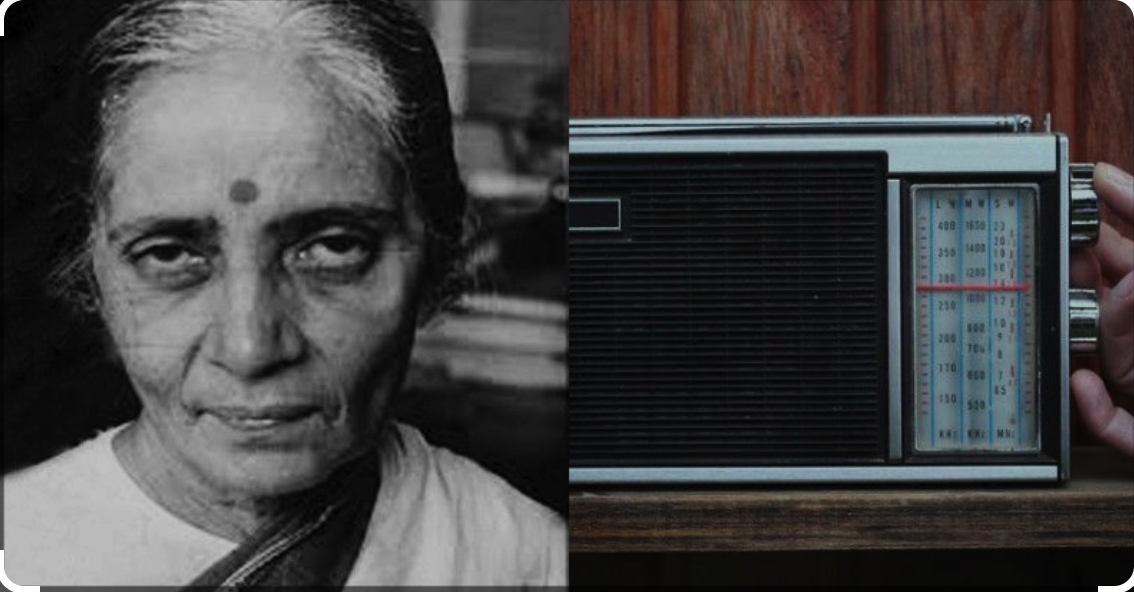
- 22 Mar 2024
Why is it in the News?
A recent film has been launched, depicting the inspiring life story of Indian freedom fighter Usha Mehta.
About Usha Mehta:
- Born in 1920 in the village of Saras, near Surat in Gujarat, Usha Mehta, affectionately known as Ushaben, embodied the Gandhian principles of non-violence and civil disobedience from a young age.
Early Activism:
- At the tender age of eight in 1928, she participated in a protest march against the Simon Commission, demonstrating her early commitment to India's independence struggle.
- The Secret Congress Radio: In 1942, amidst the fervor of the Quit India Movement, Usha Mehta and her colleagues boldly established the Secret Congress Radio.
- This clandestine radio station played a pivotal role in connecting freedom movement leaders with the masses, ensuring the dissemination of crucial information, and maintaining the spirit of resistance against colonial rule.
Establishing an Underground Radio Station:
- With the outbreak of the War in 1939, the British government imposed stringent measures, including the suspension of all amateur radio licenses throughout the Empire.
- Operators were mandated to surrender their equipment to the authorities, under threat of severe repercussions for non-compliance.
Key Figures in the Operation:
- Usha Mehta, alongside Babubhai Khakar, Vithalbhai Jhaveri, and Chandrakant Jhaveri, played instrumental roles in orchestrating the Congress Radio initiative, defying the ban on amateur radio broadcasting.
The Congress Radio Trial:
- The trial of the five accused individuals—Usha Mehta, Babubhai Khakar, Vithalbhai Jhaveri, Chandrakant Jhaveri, and Nanak Gainchand Motwane, who facilitated crucial equipment—captivated public attention in Bombay.
- While Vithalbhai and Motwane were acquitted, Mehta, Babubhai, and Chandrakant faced severe sentences for their involvement.
Usha Mehta's Legacy:
- Following her release from Pune's Yerawada Jail in March 1946, Usha Mehta was lauded in nationalist circles as "Radio-ben," symbolizing her courageous defiance and commitment to the freedom struggle through underground broadcasting.
Independence, PhD, & Padma Vibhushan
- When India finally achieved independence in 1947, the British had divided the country into two parts – India and Pakistan, sending the region into chaos.
- The divide results in massive bloodshed with more than 10 million Hindus, Muslims, and Sikhs seeking to find their home.
- Mehta was torn. “In a way, I was very happy, but sad at the same time because of partition.
- It was an independent India but a divided India,” she was quoted as saying in the book Freedom Fighters Remembered.
- She was away from active politics in independent India due to her ill health but continued to remain a staunch Gandhian till the very end.
- She penned the script for a documentary on Gandhi produced by her colleague at the radio station, and earned a PhD in Gandhian thought at the University of Bombay.
- She taught political science and ran the politics department at the university.
- She also taught at Wilson College for 30 years.
- She was also the president of the Gandhi Peace Foundation.
- In 1998, she was awarded India’s highest civilian honor, the Padma Vibhushan.
- She lived a simple life and never married or had children.
- She died on 11 August 2000 at the age of 80.
Honoring, the Architect of Mumbai (Bombay)
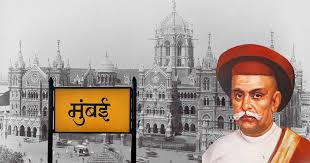
- 15 Mar 2024
Why is it in the News?
The Maharashtra cabinet recently decided to ask the Ministry of Railways to rename Mumbai Central Station after Nana Jagannath Shankarseth.
Who was Nana Jagannath Shankarseth?
- Nana Jagannath Shankarseth was a social reformer, educationist, and philanthropist and often described as the “architect” of Mumbai (then Bombay).
- He made extremely valuable contributions in terms of both ideas and money to multiple sectors, to lay a strong foundation for the city.
- Shankarseth was greatly inspired by the legendary merchant and philanthropist Sir Jamsetjee Jeejeebhoy.
- As a social reformer and community leader, Shankarseth earned the goodwill of both Indians and the British.
- He became the first Indian to be nominated to the Legislative Council of Bombay.
Shankarseth’s Most Significant Contributions:
- Education: Shankarseth was deeply committed to the growth and spread of education in Bombay, and donated land owned by his family for educational institutions.
- Like many social reformers of his age, he believed that Indians could progress through education.
- He also worked for the education of girls and women.
- Shankarseth founded the Native School of Bombay, which was renamed first as the Bombay Native Institution, and then as the Board of Education.
- Finally, this institution evolved into the prestigious Elphinstone College.
- Museum, Temples: Shankarseth was among the wealthy donors who helped promote Dr Bhau Daji Lad Museum in Byculla, which was designed by a famous London-based architect.
- The Bhawani Shankar Temple near Nana Chowk was Shankarseth’s tribute to his late mother Bhawanibai Murkute.
- He also built a Ram temple.
- Railways: The first train in India ran between Boribunder and Thane on April 16, 1853.
- The 34-km project was undertaken by the Great Indian Peninsular Railway Company.
- The committee that gave the project impetus included Sir Jamsetjee Jeejeebhoy and Nana Shankarseth.
Kamaladevi Chattopadhyay, the unsung feminist freedom fighter in the history of India
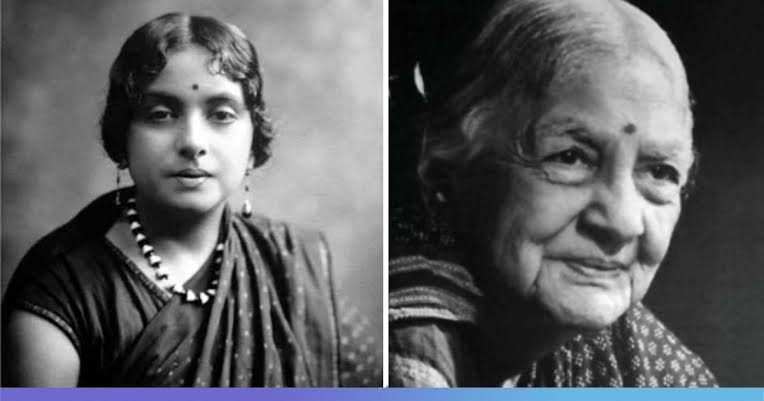
- 09 Mar 2024
Why is it in the News?
Post-Independence, the revival of the crafts sector began with Kamaladevi Chattopadhyay who strongly championed the handicrafts movement for the role it could play in social and economic upliftment.
About Kamaladevi Chattopadhyay:
- Kamaladevi was born in April 1903 in a liberal Chitrapur Saraswat Brahmin family in Mangalore (now Mangaluru).
- She completed her primary education at the local St Ann’s Convent.
- Growing up in a land with a rich cultural heritage, especially of the music and dance form Yakshagana, she developed a taste for traditional art forms.
- After her father’s untimely death, Kamaladevi moved to her maternal uncle’s house.
- There, she met renowned freedom fighters, including Gopalkrishna Gokhale, Srinivasa Shastri, Ramabai Ranade and Annie Besant.
- Kamaladevi was married off at the age of 14 and widowed two years later.
- Unperturbed by these life events, she joined Queen Mary’s College in Madras (now Chennai) for higher studies.
- There, she met Sarojini (Chattopadhyay) Naidu’s brother Harindranath Chattopadhyay which led to their wedlock.
- However, their marriage ended over incompatibility issues and this, too, created history – Kamaladevi was the first legal divorce granted through an Indian court of law.
- Kamaladevi played a prominent role in political reforms and India’s freedom struggle.
- She was the first woman to contest the Madras provincial elections.
- Though she lost by a narrow margin, she got recognition and was appointed secretary of the All-India Women’s Conference.
- She joined Indian National Congress in 1927 and was elected to the All-India Congress Committee within a year.
- During the Salt March to Dandi, she convinced Gandhi to give women equal opportunity to be in the forefront of the march.
- Later, she joined Seva Dal and trained women activists.
- However, the British government banned Seva Dal and threw Kamaladevi into jail.
- There, she contracted jaundice. Having experienced the pathetic condition of the prison hospital, she built a hospital for inmates upon release.
- Kamaladevi got attracted to socialism and took up the problems of laborers and peasants.
- During World War II, she visited America and met several political activists, mostly blacks, and shared with them India’s non-violent approach to freedom struggle.
- The British got wind of her activism and banned her from returning to India.
- Unmoved, Kamaladevi continued on her journey, visiting South Africa, China, Japan and Vietnam.
- Kamaladevi was inarguably the embodiment of women’s empowerment.
- She was an advocate of female sexual freedom and birth control.
- Her remarriage after widowhood and legal divorce from her second marriage were symbolic of her self-empowerment.
- She acted in many films (a Kannada film, too) when the film industry was not considered a respectable place for women.
- Indeed, Kamaladevi’s immense travel and experiences shaped her as a secular, socialist world citizen.
- Such were her ideals that led to her building the city of Faridabad to rehabilitate some 50,000 craftsmen who moved to India from Pakistan during Partition.
- Post-independence, she helped revive Indian handicrafts and built institutions for a ‘New India’-- to name a few, the National School of Drama, Bharatiya Natya Sangha, Lady Irwin College, Sangeet Natak Academy, Central Cottage Industries Emporium, World Craft Council, Craft Council of India, and the Delhi Craft Council.
- Kamaladevi was a prolific writer, too and wrote 18 books altogether, touching upon women’s issues, Indian handicrafts and her foreign visits.
- She published her autobiography, “Inner Recesses, Outer Spaces: Memoir” (1986).
- She received several awards in recognition of her public service, like Padma Bhushan and Padma Vibhushan, the Ramon Magsaysay Award and the UNESCO Award.
- She died in Mumbai on October 29, 1988, aged 85.
Controversy Erupts as Tamil Nadu Governor Refers to Ayya Vaikundar as 'Sanatan Dharma Savior'
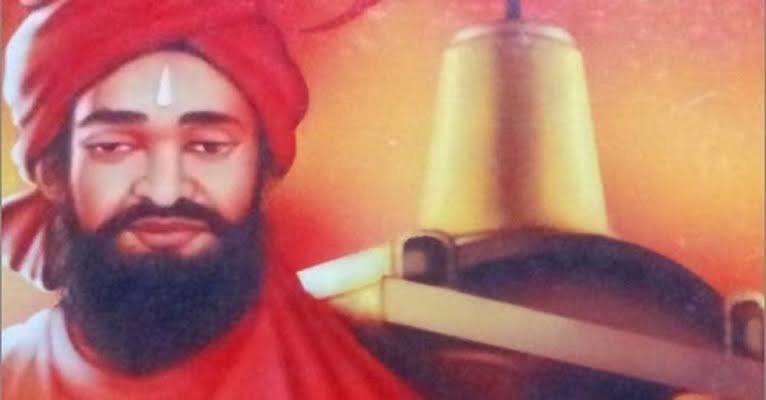
- 07 Mar 2024
Why is it in the News?
Tamil Nadu Governor R N Ravi’s recent remarks about the 19th-century social reformer Ayya Vaikundar — that he was Lord Vishnu incarnated to prevent the destruction of Sanatan Dharma — have evoked sharp reactions in the state, from politicians as well as Vaikundar’s followers.
Who was Ayya Vaikundar?
- Ayya Vaikundar, born in 1809, is revered as a social reformer and the founder of the Ayyavazhi sect, primarily in southern Tamil Nadu.
- His teachings focused on equality, fraternity, and the eradication of caste-based discrimination, challenging the established religious and social hierarchies of the time.
- At a time when rigid casteism and caste-based atrocities were the norm, Vaikundar introduced measures to challenge these divisions.
- He organized Samapanthi-bhojana or community eateries for people from all backgrounds.
- He would send his disciples to the homes of lower castes to eat with them.
- When lower castes were not allowed to fetch water from wells used by upper caste Hindus, Vaikundar initiated the digging of common wells, called Muthirikinarus.
- At a time when priests threw vibhuti and sandal paste at devotees from a distance to avoid touching them and lower castes were not allowed to enter temples at all, Vaikundar introduced Thottu Namam, in which he inspired priests to apply the sacred paste on devotees’ forehead, irrespective of their caste.
- The paste would be applied in the form of a lamp, indicating the soul and God, representing the form of God inside every life.
- Vaikundar also encouraged all devotees to wear turbans and dhotis, promoting equality.
- He initiated the Thuvayal Panthy programme, teaching vegetarianism and discipline to followers, who spread these teachings across Tamil Nadu.
- He established Nizhal Thangals as community worship spaces, which did not have any idol or deity, and only Tamil was used for worship.
- These community worship centers also had community kitchens and even basic schools.
- He pioneered education for the lower castes and opposed discriminatory taxes.
- One of his significant interventions was the introduction of simplified, inclusive marriage customs without a Brahmin priest or Sanskrit mantras.
After 30 years, Buddha relics travel to Thailand
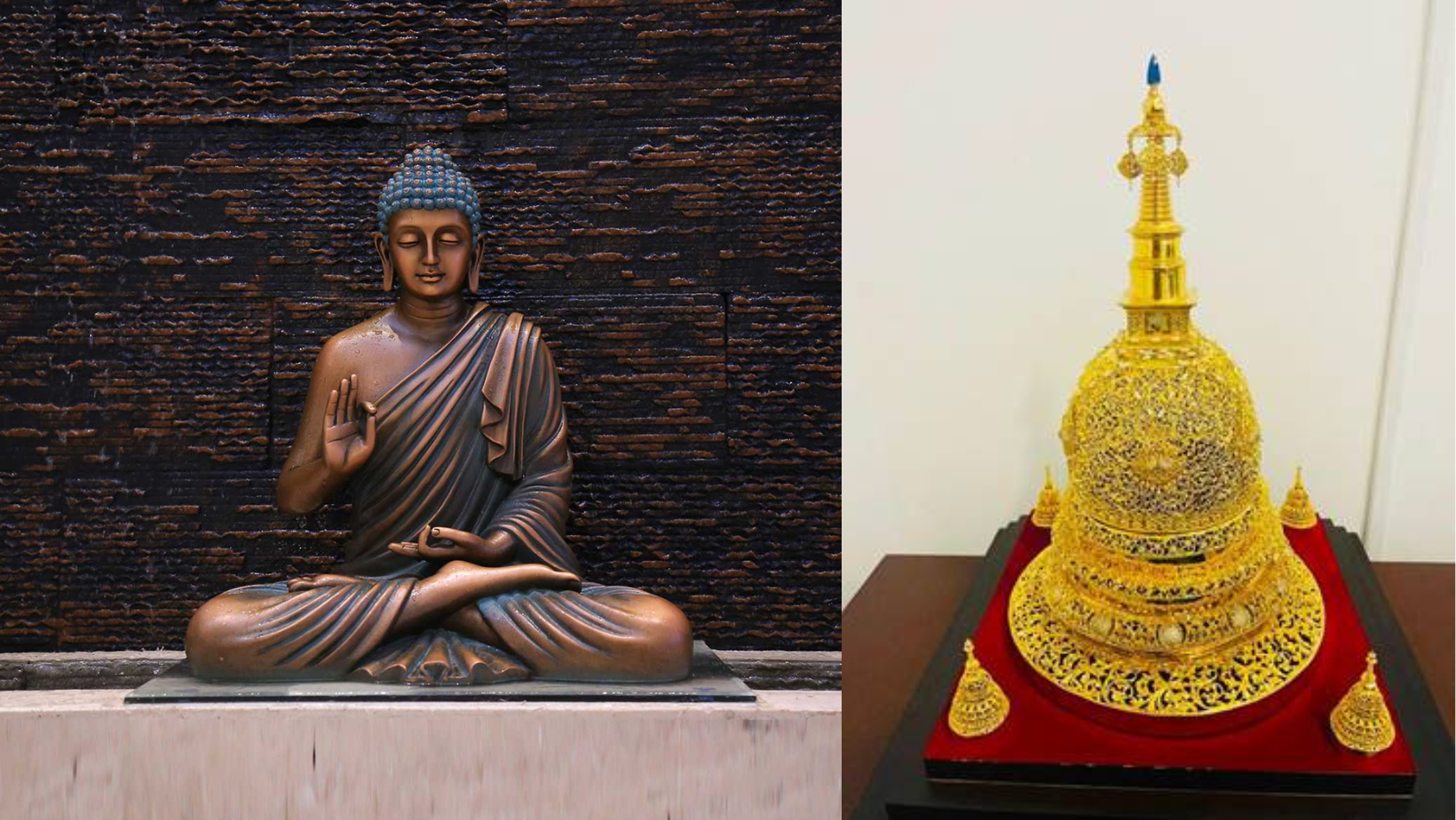
- 21 Feb 2024
Why is it in the News?
Four of the 20 relics of Lord Buddha preserved at the National Museum are being taken to Thailand for a month-long exposition beginning recently, in a rare trip abroad for the delicate antiquities recovered more than a century ago.
About the Relics of Lord Buddha:
- The relics of Lord Buddha and his disciples Arahata Sariputra and Arahata Maudgalayana are known as the ‘Kapilvastu Relics.’
- The relics date back to around the 4th or 5th Century BC.
- They were found in Bihar’s Piprahwa — a site that is believed to be the ancient city of Kapilvastu.
- Piprahwa today is located in Uttar Pradesh’s Siddharthnagar district.
- The relics were discovered by a team of Archaeological Survey of India (ASI) officials in the 1970s.
- The ASI conducted excavations at Piprahwa from 1971-77 under the supervision of the archaeology director KM Srivastava.
History:
- Lord Buddha achieved Mahaparinirvana at the age of 80 in Kushinagar.
- The Mallas of Kushinagara cremated his body with ceremonies befitting a ‘Universal King’ (‘cakravartin’).
- His holy relics, from the funeral pyre, were collected, divided and given by Brahmin priest Dhona of Kushinagar to kings and priests.
- The eight shares were distributed among Ajatashatru of Magadha, the Licchavis of Vaishali, the Sakyas of Kapilavastu, Mallas of Kushinagar, Bullies of Allakappa, the Mallas of Pava, the Koliyas of Ramagrama and a Brahmana of Vethadipa.
- The sacred relics were commemorated in eight different stupas.
- Two more stupas came into existence, one over the urn in which the relics had been collected and one over the embers.
- Thus, stupas erected over the bodily relics of Buddha (Saririka-stupas) are the earliest surviving Buddhist shrines.
- It is stated that Ashoka (circa 272-232 BC), being an ardent follower of Buddhism, opened up seven of these eight stupas, and collected a major portion of the relics for enshrinement within innumerable stupas built by him to popularise Buddhism and spread dharma.
- In 1898, the discovery of an inscribed casket by William Claxton Peppé, a British colonial engineer and an estate manager at a Buddhist stupa site at Piprahwa, was an epoch-making incident.
- The inscription on the lid referred to the relics of Buddha and his community.
- The bone relics present in the stone coffer were presented to King Rama V of Thailand.
- The relics were further divided into three shares and gifted to Thailand, Myanmar and Sri Lanka.
- In Thailand, the holy relic has been enshrined in a chedi on the top of Suwanbanphot, Bangkok.
- Every year, during the Loi Krathong Festival, there is a seven-day and seven-night celebration, which has become a tradition to worship the Buddha’s relics.
Gold Hunt by Villagers Reveals Ancient Harappan Settlement in Gujarat
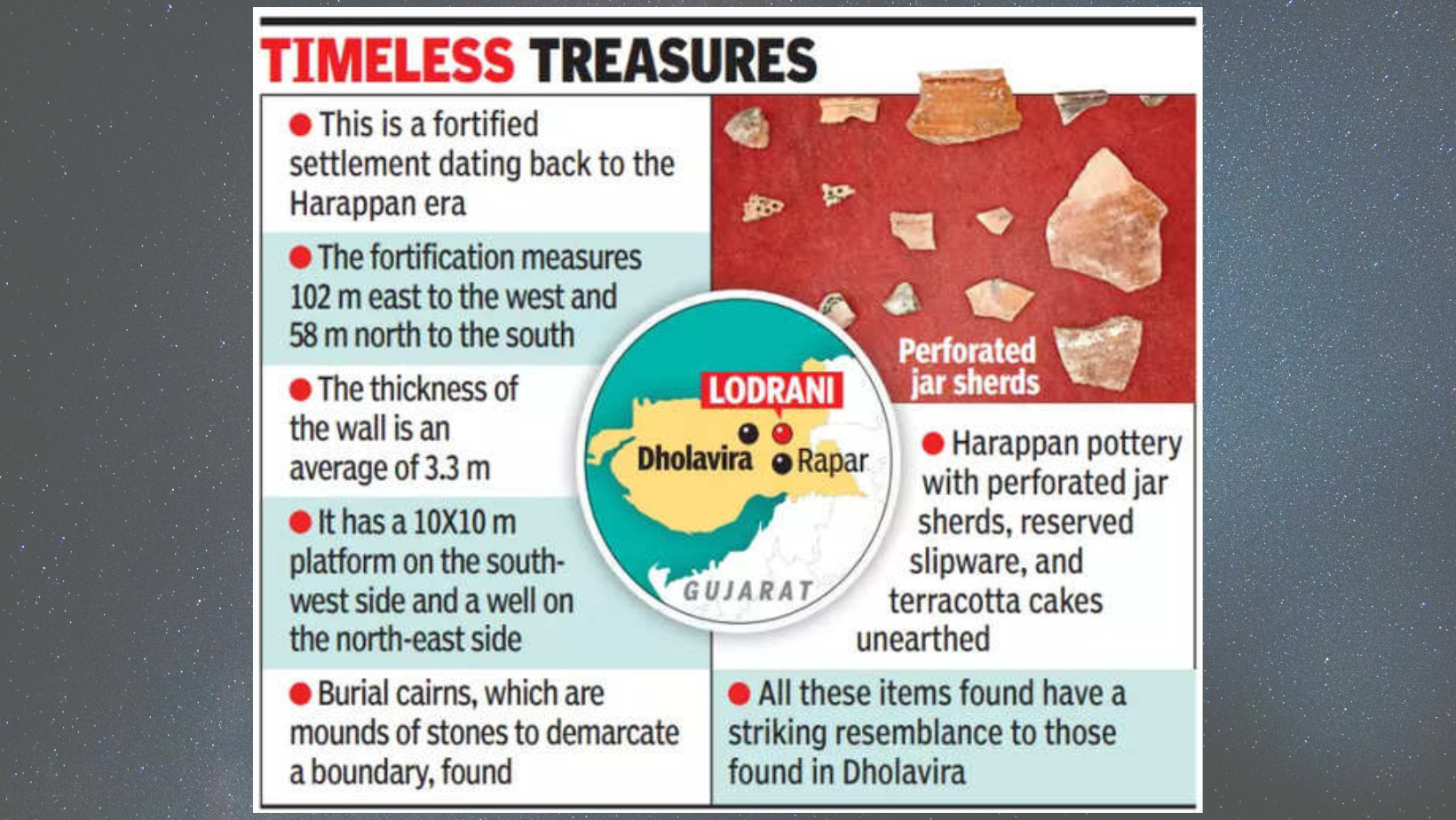
- 20 Feb 2024
Why is it in the News?
The newly discovered Harappan settlement at Lodrani village in the Kutch region of Gujarat has sparked widespread interest in the fascinating remains of this ancient civilisation, making it an important site for archaeological exploration and research.
Features of Harappan site Morodharo:
- Morodharo is a fortified settlement of the Harappan era, with the fortification measuring 102 m to the west and 58 m north to the south.
- The thickness of the wall is 3.3 m on average.
- Morodhara has a 10x10 m platform on the southwest side and a well on the northeast side.
- Burial cairns have been found at Morodharo.
- A cairn is an intentionally constructed mound of stones, typically created for marking a location or serving as a burial mound.
- Harappan pottery with perforated jar sherds, reserved slipware and terracotta cakes have also been unearthed.
- All these items have a striking resemblance to those found in Dholavira.
About Harappan Civilization:
- The Harappan civilization, also known as the Indus Valley civilization was South Asia's first urban civilization, flourishing concurrently with Mesopotamia and Egypt.
- It encompassed the most extensive territory, covering approximately 800,000 square kilometres, compared to its contemporaries.
- Prominent cities during the Harappan period included Harappa and Mohenjo-Daro in present-day Pakistan, along with Dholavira, Lothal, and Surkotada in Gujarat, India, among others.
- Urban planning in Harappan cities followed a meticulous grid layout, with streets intersecting at right angles, dividing the cities into neat rectangular blocks.
- The streets and alleys were deliberately designed for efficient movement, accommodating carts and pedestrians, often featuring covered drains alongside.
- For defence and security, the cities were enclosed by sturdy walls made of mud bricks, shielding against intruders and natural calamities.
- Each city was structured into an elevated citadel and a lower town, with the former housing monumental structures like granaries and administrative buildings.
- Residential areas comprised multi-story brick houses clustered around courtyards, some equipped with private wells and well-ventilated bathrooms.
- A sophisticated drainage system ensured efficient waste disposal, with individual house drains connected to street-level drainage networks.
- Granaries and storage facilities were strategically positioned to manage surplus agricultural yields, reflecting advanced urban planning and resource management.
Elephant Endotheliotropic Herpesvirus (EEHV) (DST Gov)
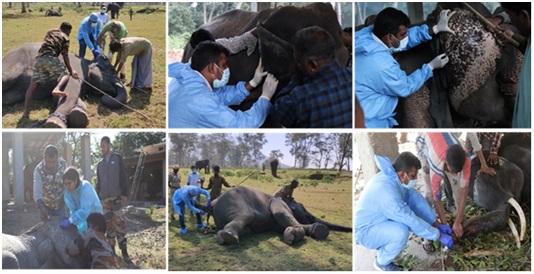
- 06 Dec 2023
Why is it in the News?
The study by ICAR-Indian Veterinary Research Institute (ICAR-IVRI), Izatnagar, Bareilly has found the exact status of EEHV and its subtypes circulating among the Asian elephant population in India.
What is Elephant Endotheliotropic Herpesvirus (EEHV)?
- Elephant endotheliotropic herpesvirus (EEHV) is responsible for one of the most devastating viral infectious diseases in elephants worldwide, especially young Asian elephants.
- EEHV is a double-stranded DNA virus that is classified in the family Herpesviridae.
- The mortality rate is very high (70-85%) and death occurs within a short period (2-4 days).
- In India, the incidence of EEHV-HD was first reported in 1997.
- 9 of 15 potential cases were confirmed from Southern India in wild free-ranging calves in Kerala, Karnataka, Tamil Nadu forest reserves, and Madras Zoo.
- Transmission of the disease: EEHV is mostly spread through mucosal secretions which include:
- Saliva, Breast milk, Nasal secretions, Trunk to trunk contacts etc
- The disease can only affect elephants and is not infectious to humans or other animals.
- Symptoms: Some elephants show symptoms such as reduced appetite, nasal discharge and swollen glands.
- Treatment: Treatment involves a combination of strategies such as antiviral therapy, aggressive fluid therapy to counter haemorrhaging, immuno-stimulant drugs like selenium and Vitamins C and E, as well as antipyretics and analgesics to manage fever.
- It's important to note that there is no definitive cure for herpesviruses in animals or humans since these viruses typically enter a latent state.
Scientists uncover seismic clues in Kopili Fault zone, advancing earthquake preparedness (PIB)
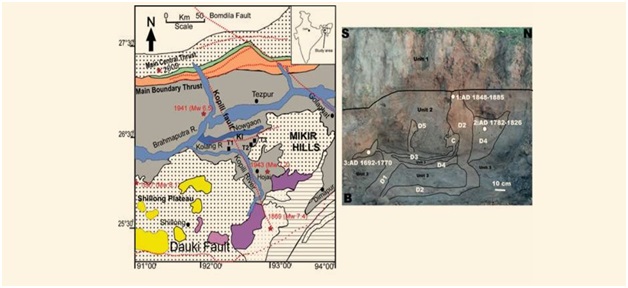
- 06 Dec 2023
Why is it in the News?
Recently, scientists at the Indian Institute of Geomagnetism (IIG) have detected seismogenic liquefaction characteristics within the dynamically active Kopili Fault (KF) zone.
About Kopili Fault Zone:
- The Kopili Fault extends from the western part of Manipur up to the tri-junction of Bhutan, Arunachal Pradesh and Assam.
- It covers a distance of about 400 km and is closer to the Himalayan Frontal Thrust.
- The Kopili fault bisects the Meghalaya Plateau and isolates the Mishmi block from the main part of the plateau.
- The Kopili fault is almost passing through the Kopili River.
- The river Kopili rises in the North Cachar Hills District in Borail Range at an altitude of 1525 meters.
- From a field study, it is observed that the Kopili Fault region is moving in the northeast direction at an average velocity of 28.397N mm/yr and 40.227E mm/yr.
- This region is characterized by heightened seismic activity, classified within the most critical Seismic Hazard Zone V.
- The geological dynamics are attributed to collisional tectonics, where the Indian Plate subducts beneath the Eurasian Plate.
- The fault itself is a transpressional fracture, producing dextral strike-slip earthquakes in the lower crust.
- The Kopili fault zone, a tectonic depression filled by the alluvium of the Kopili River and its tributaries, has experienced numerous seismic events, notable among them being the 1869 earthquake (magnitude 7.8) and the 1943 earthquake (magnitude 7.3).
